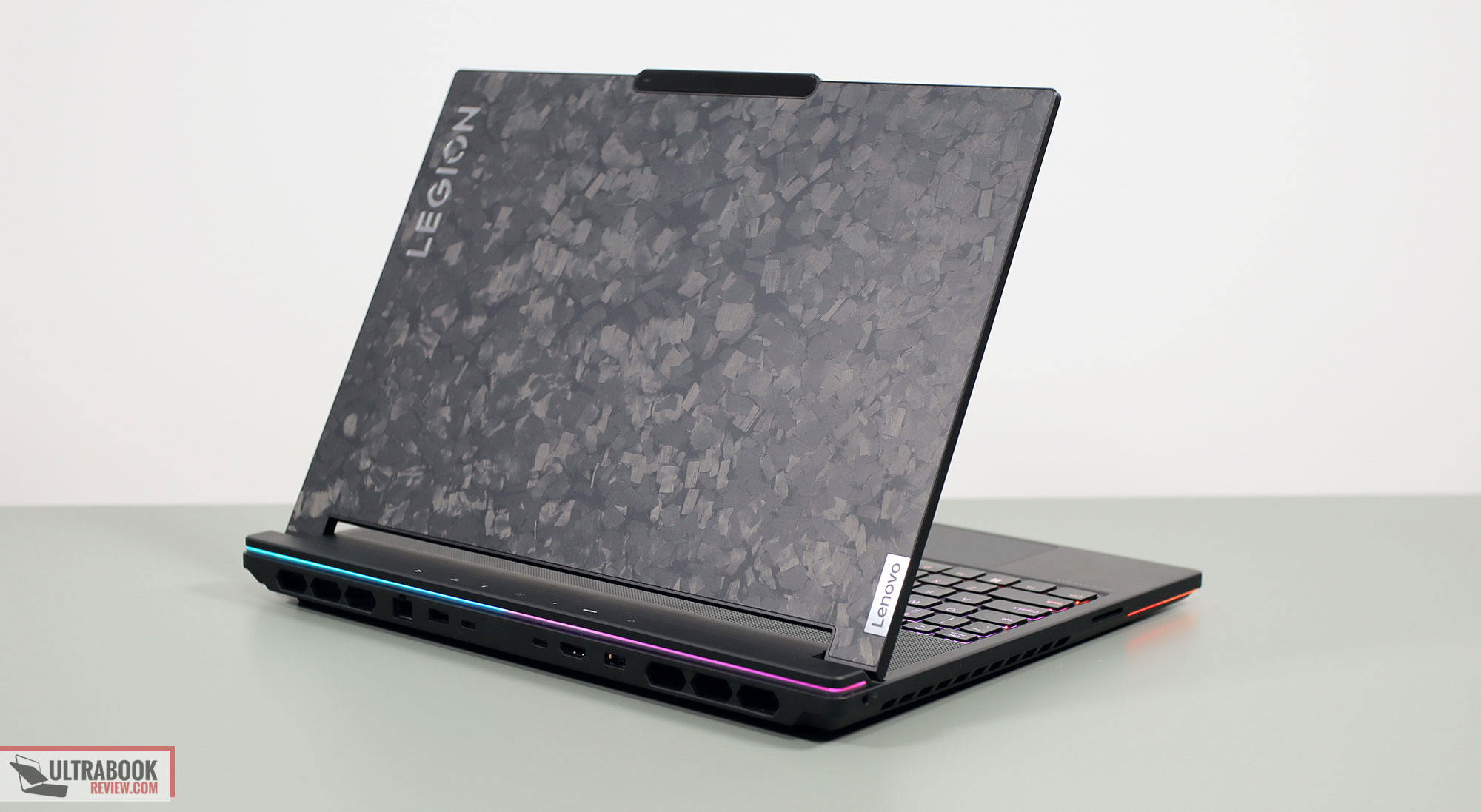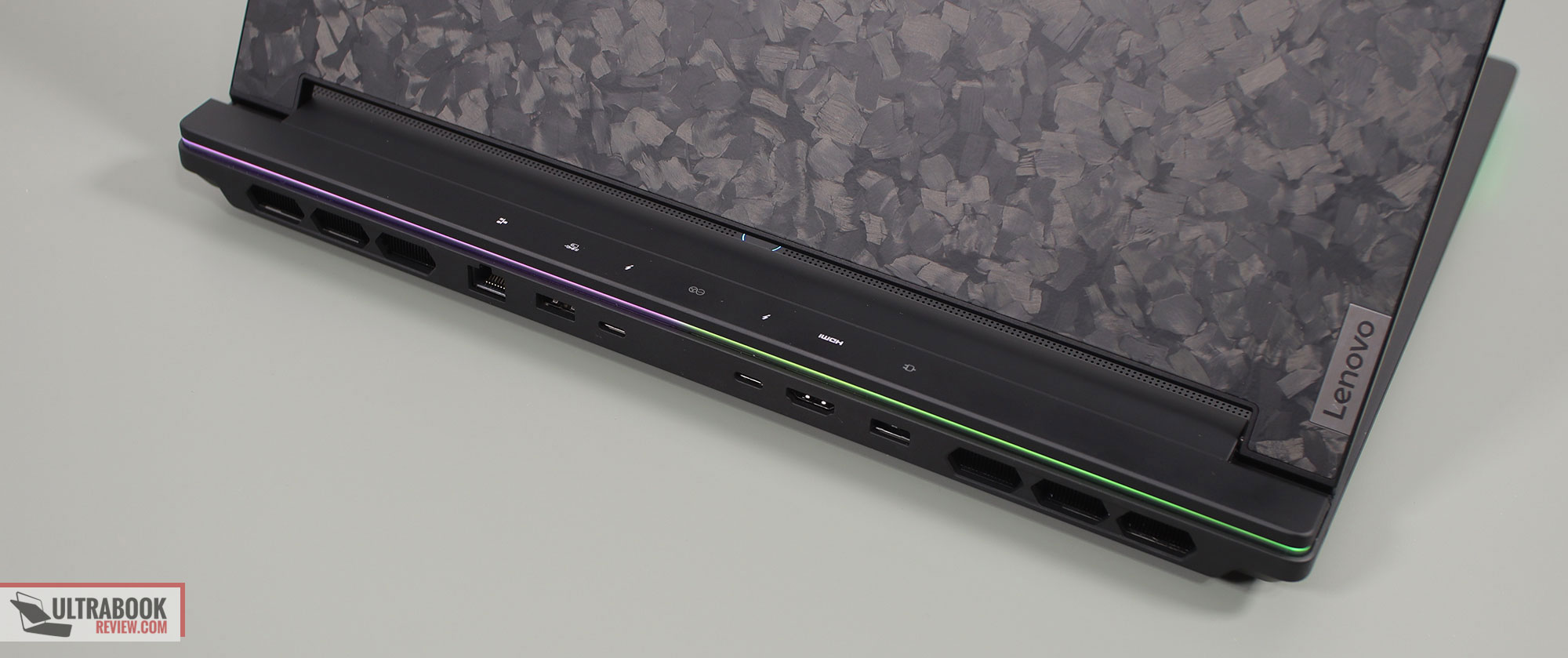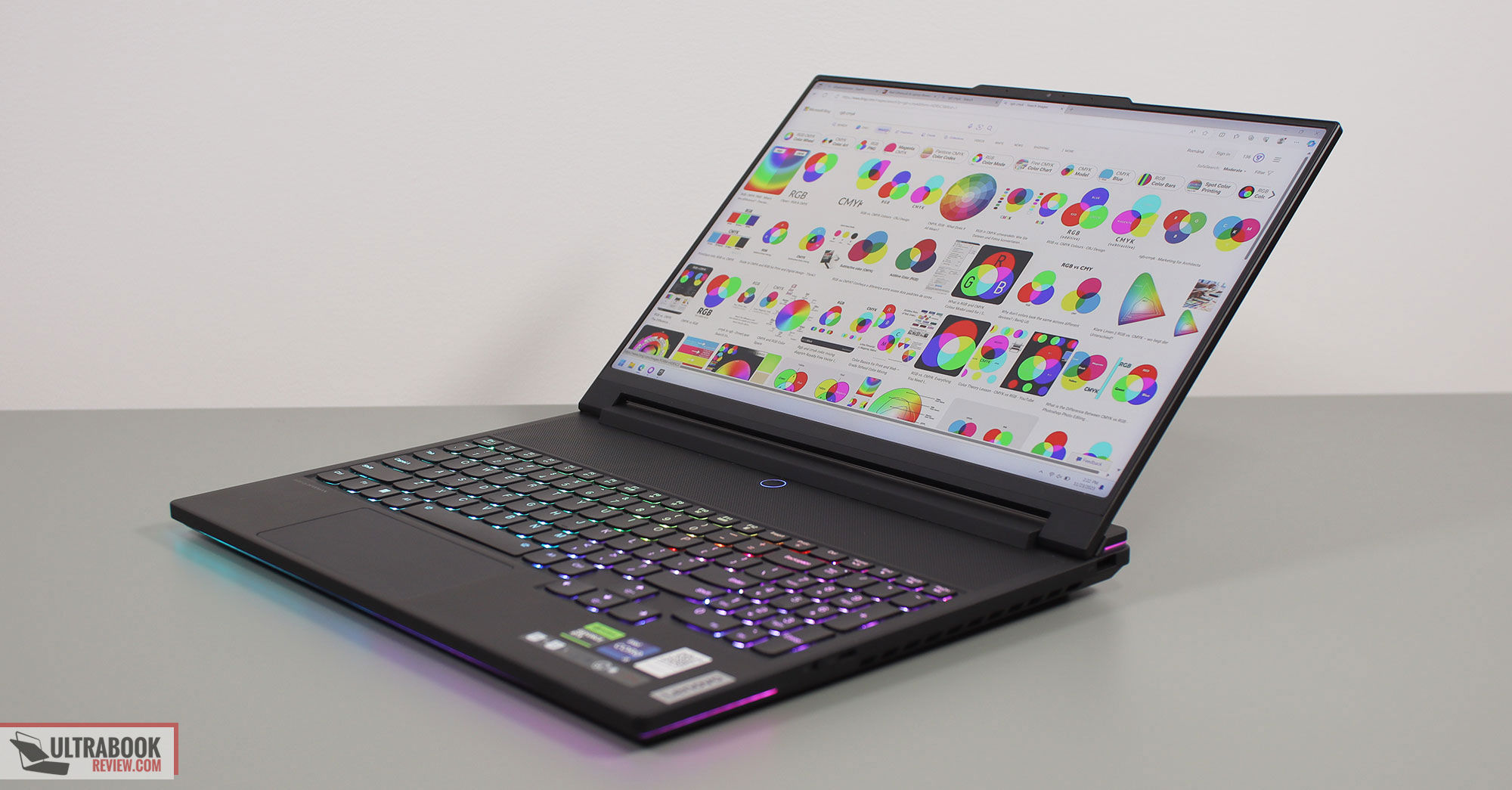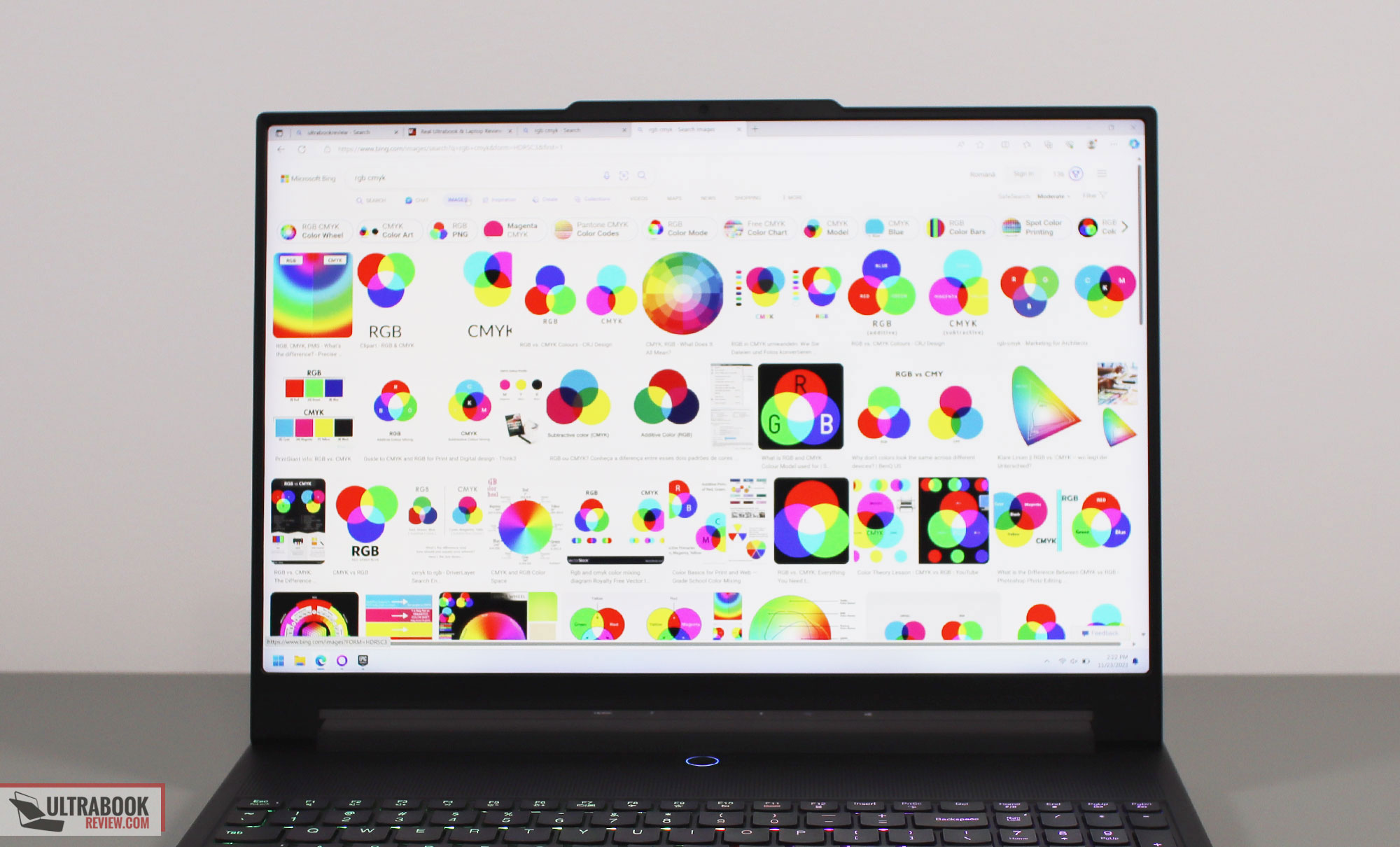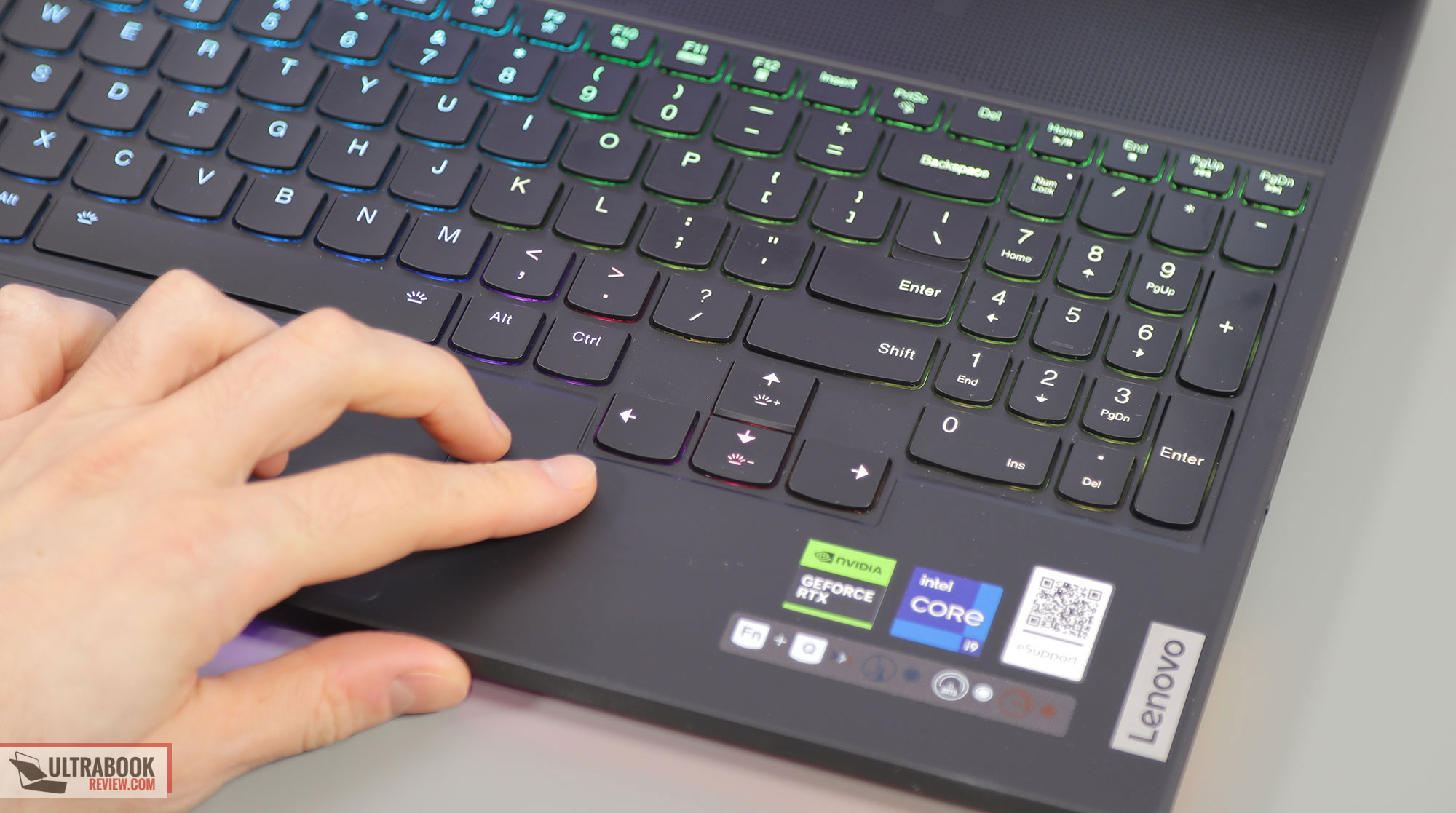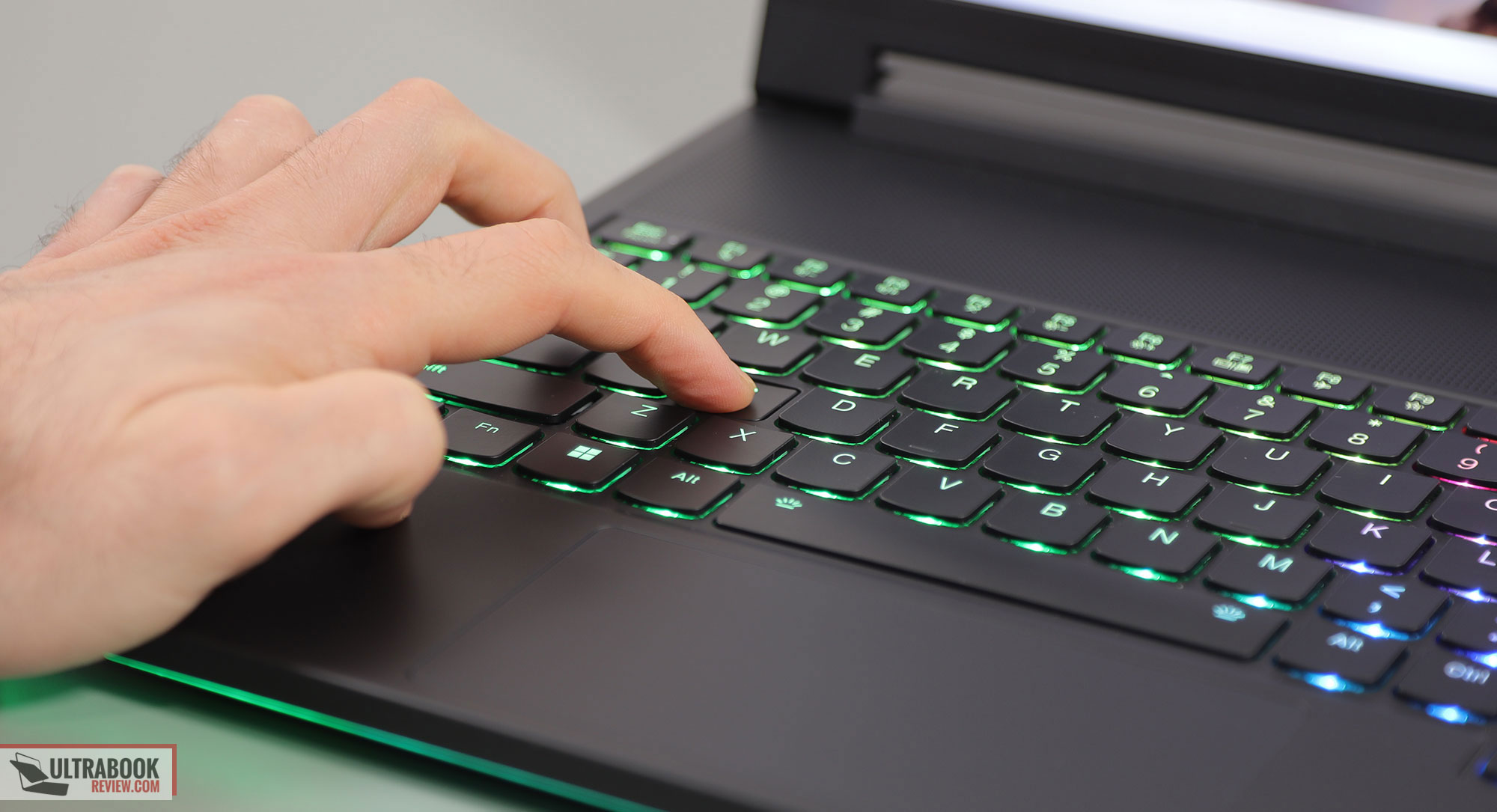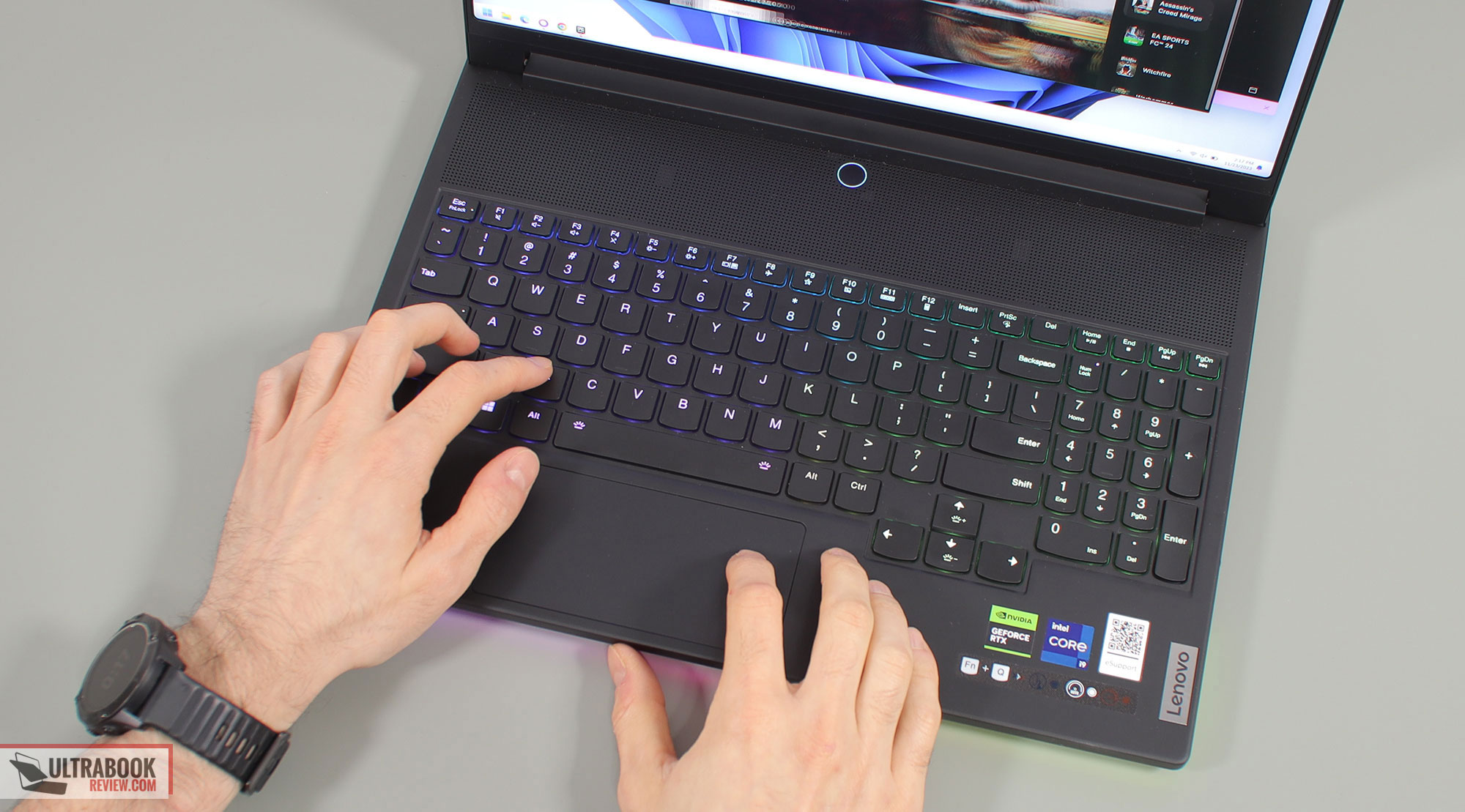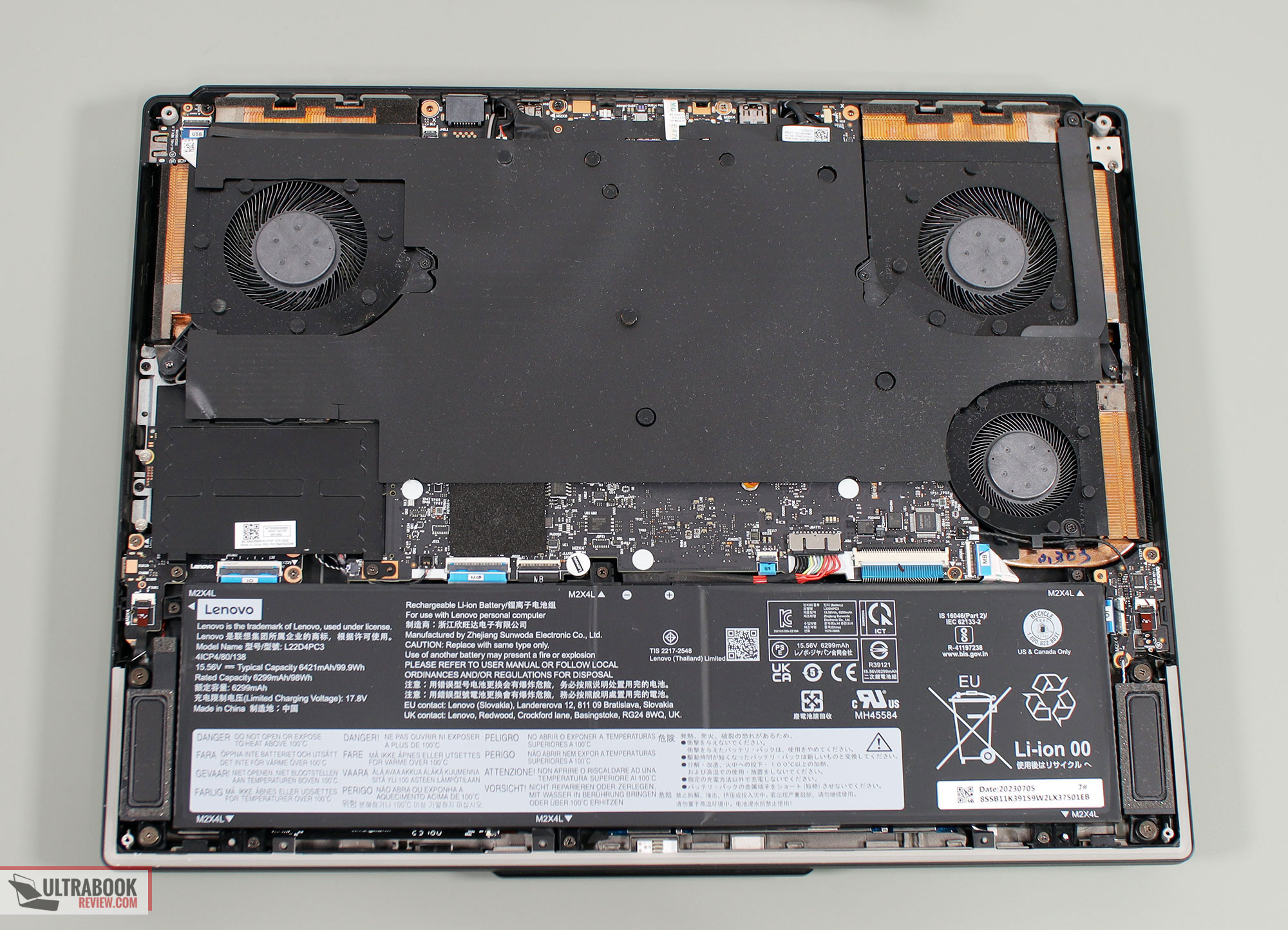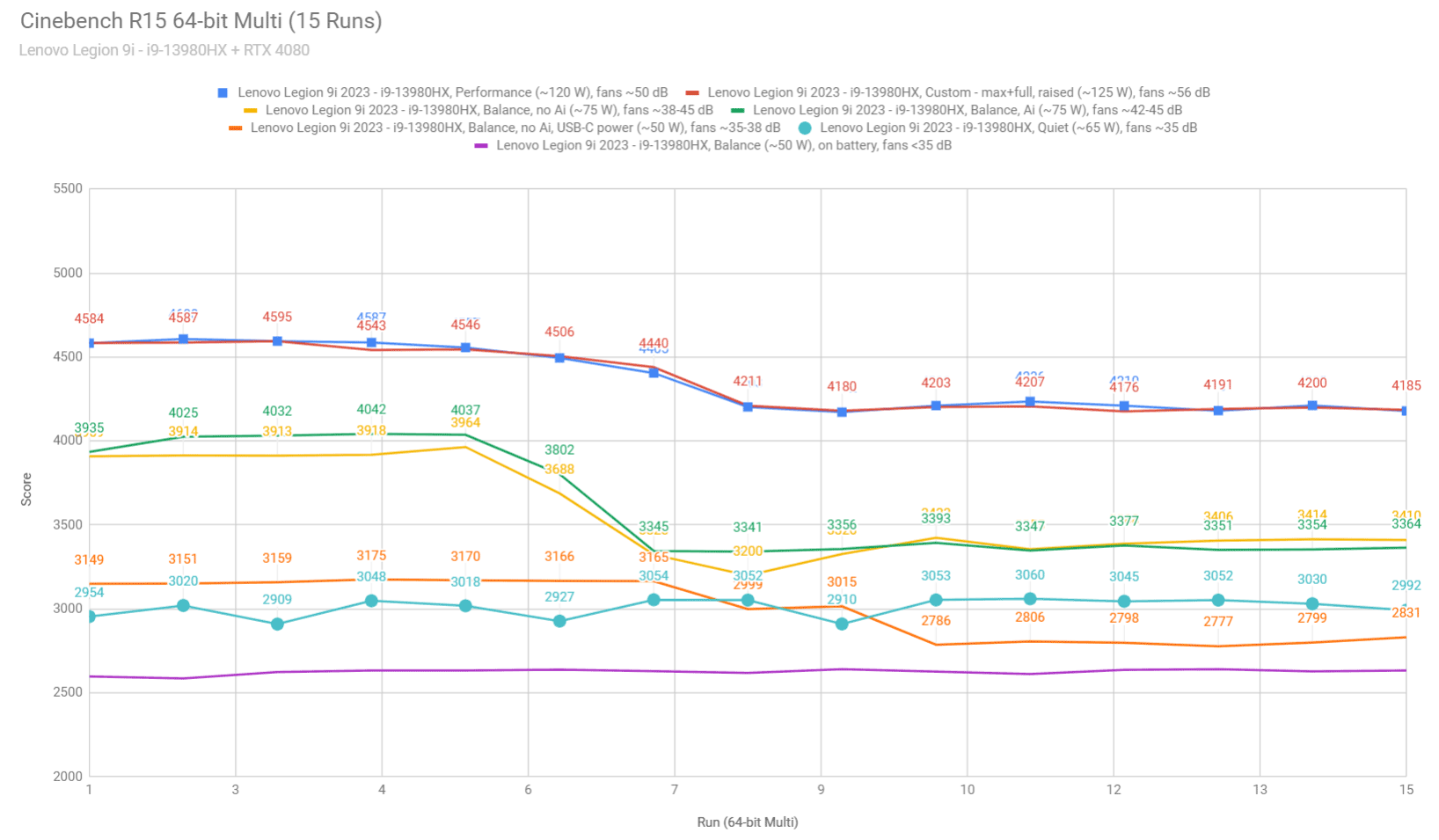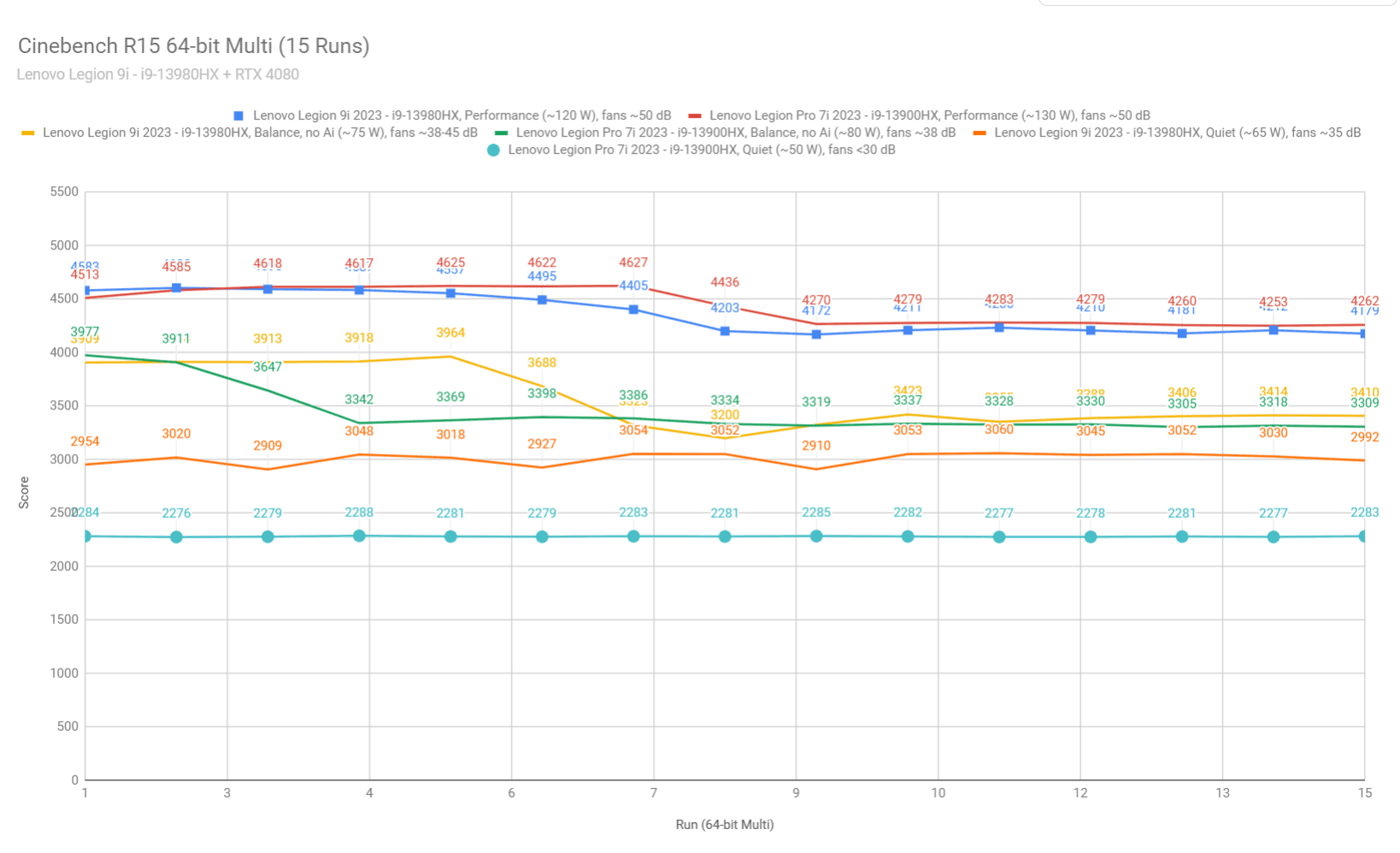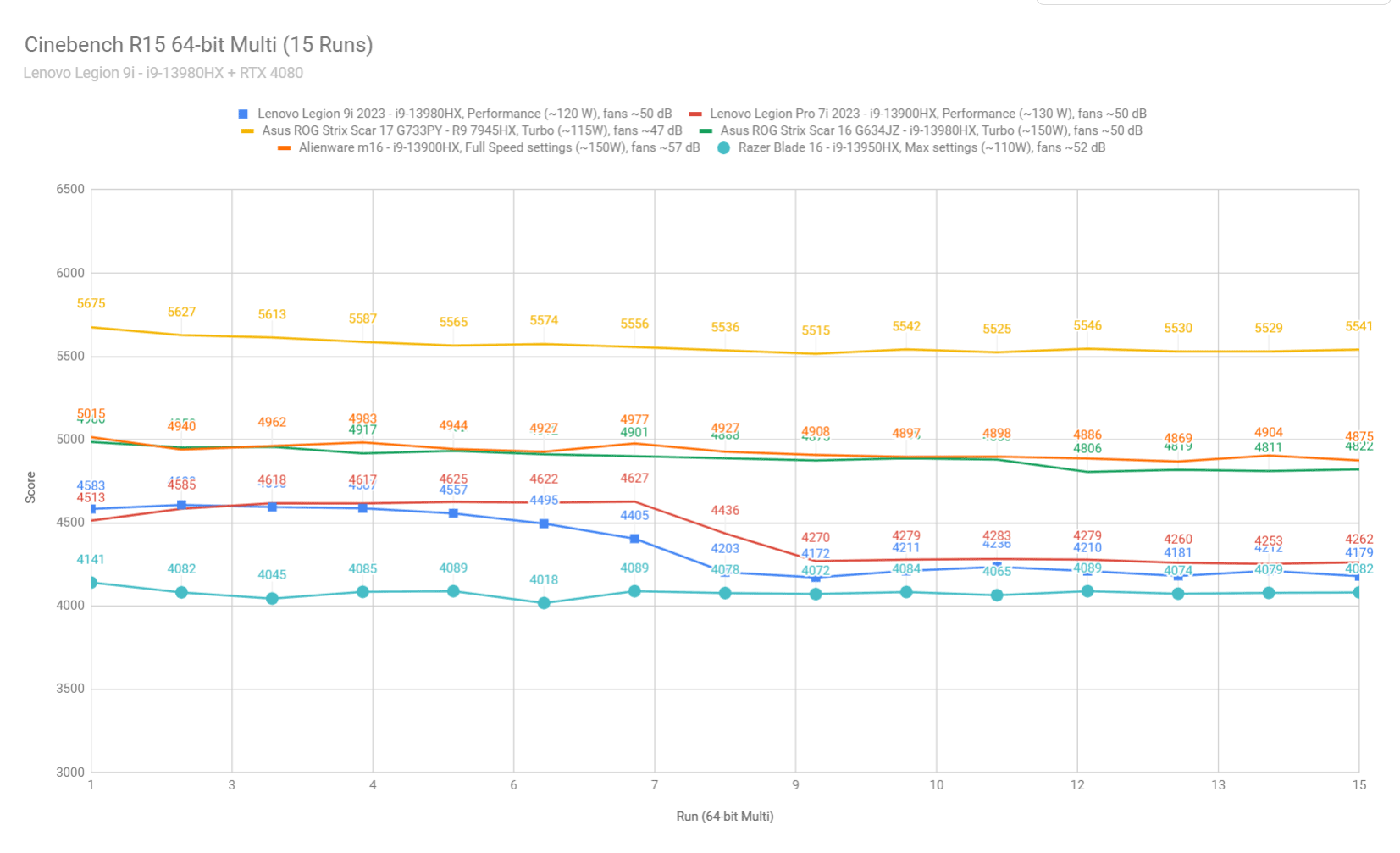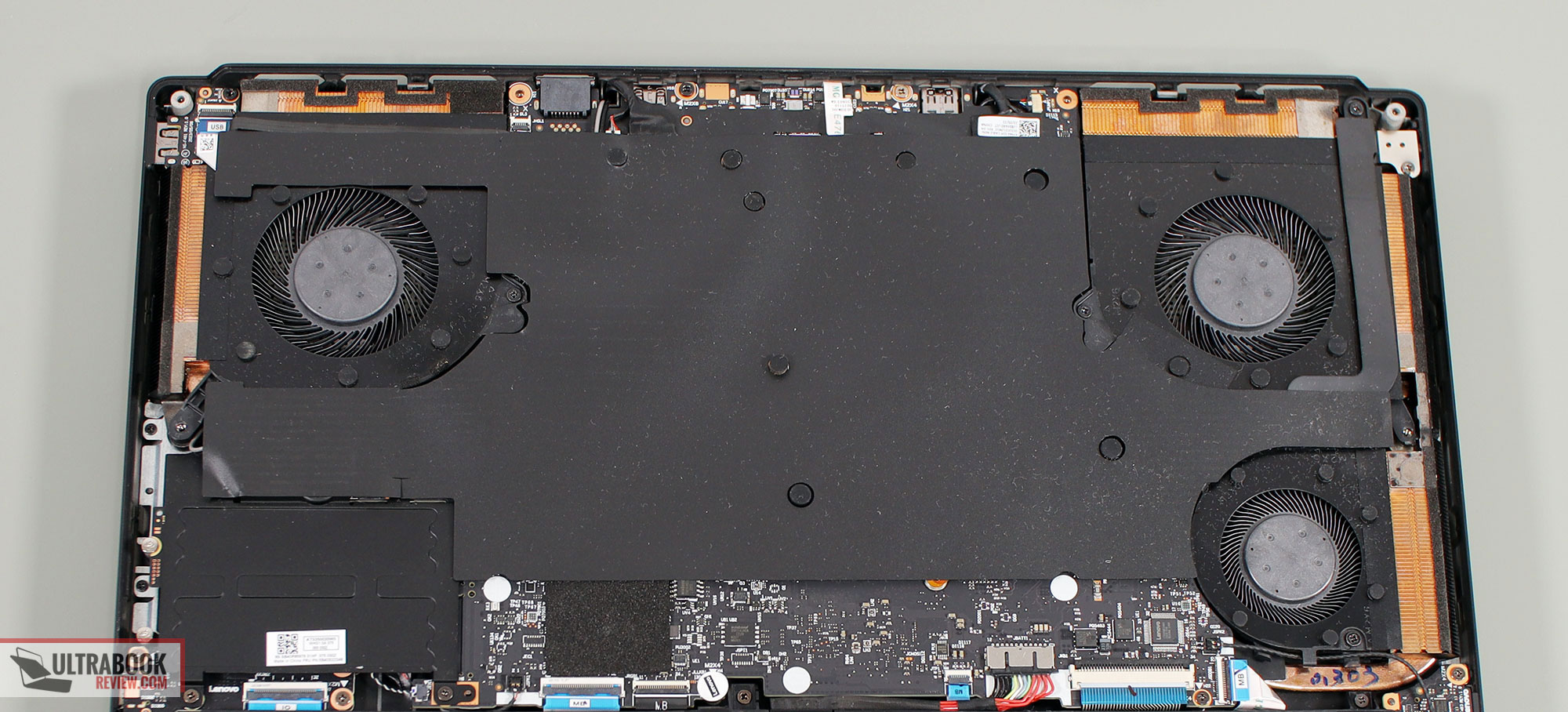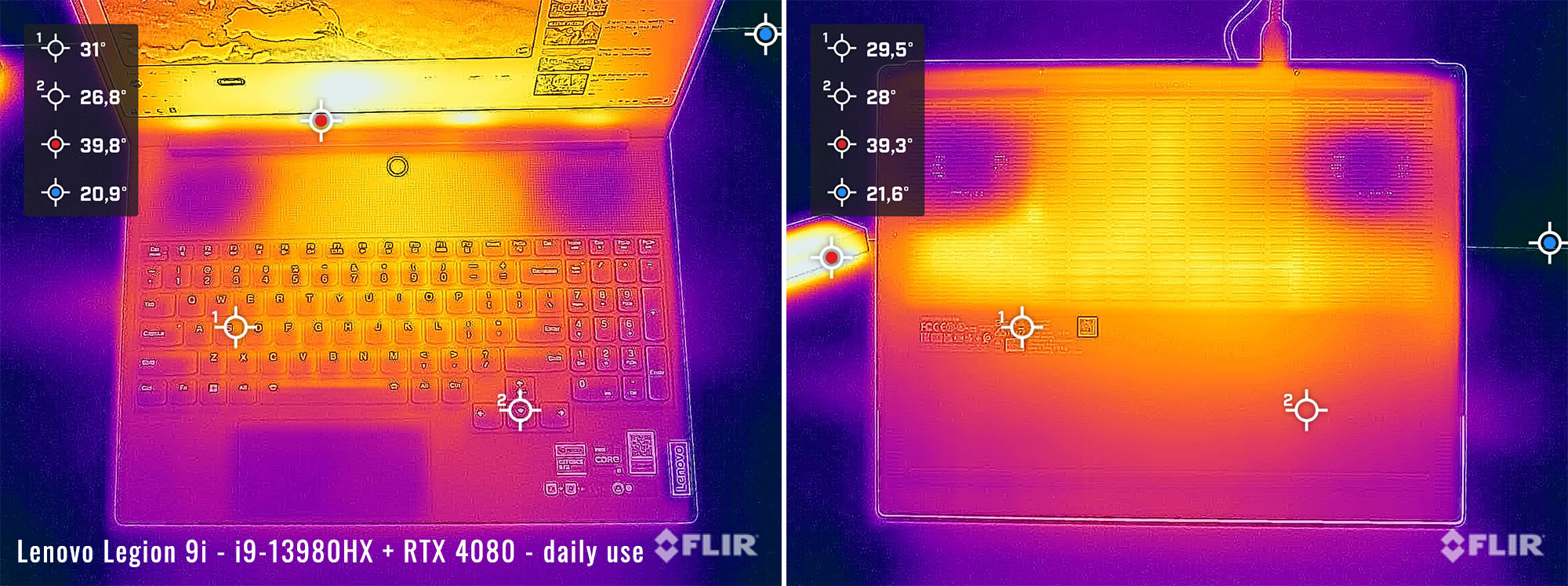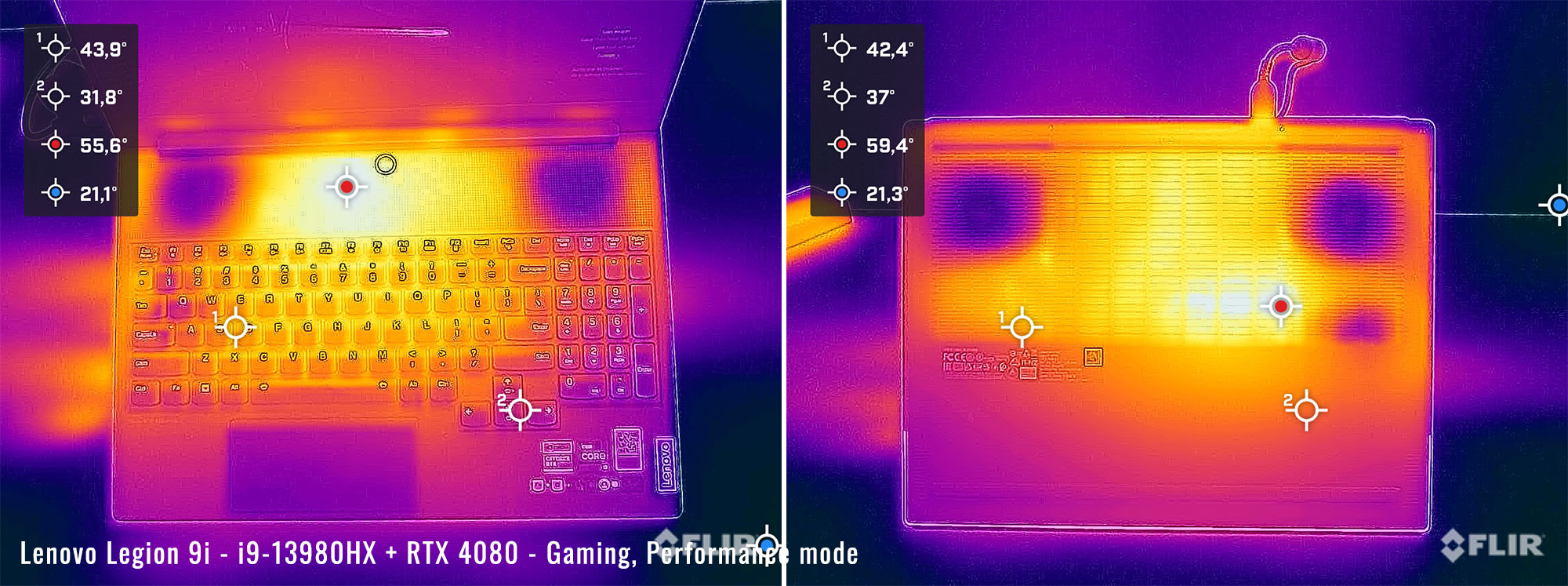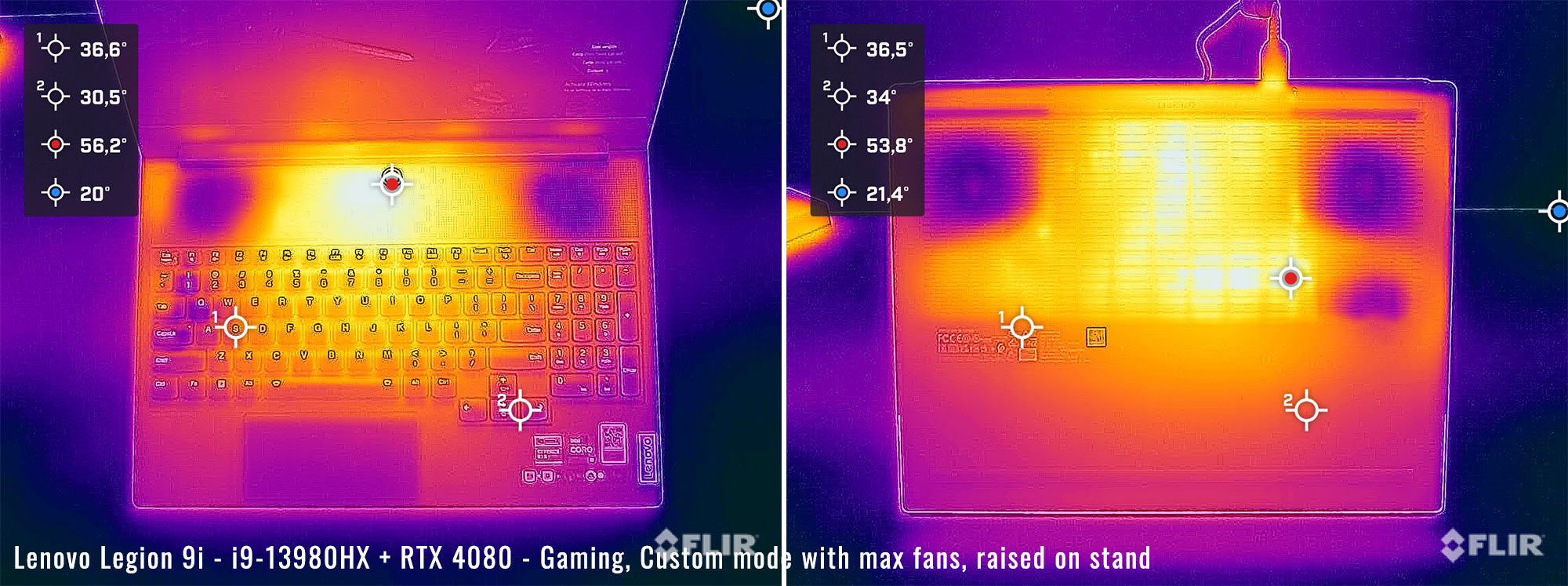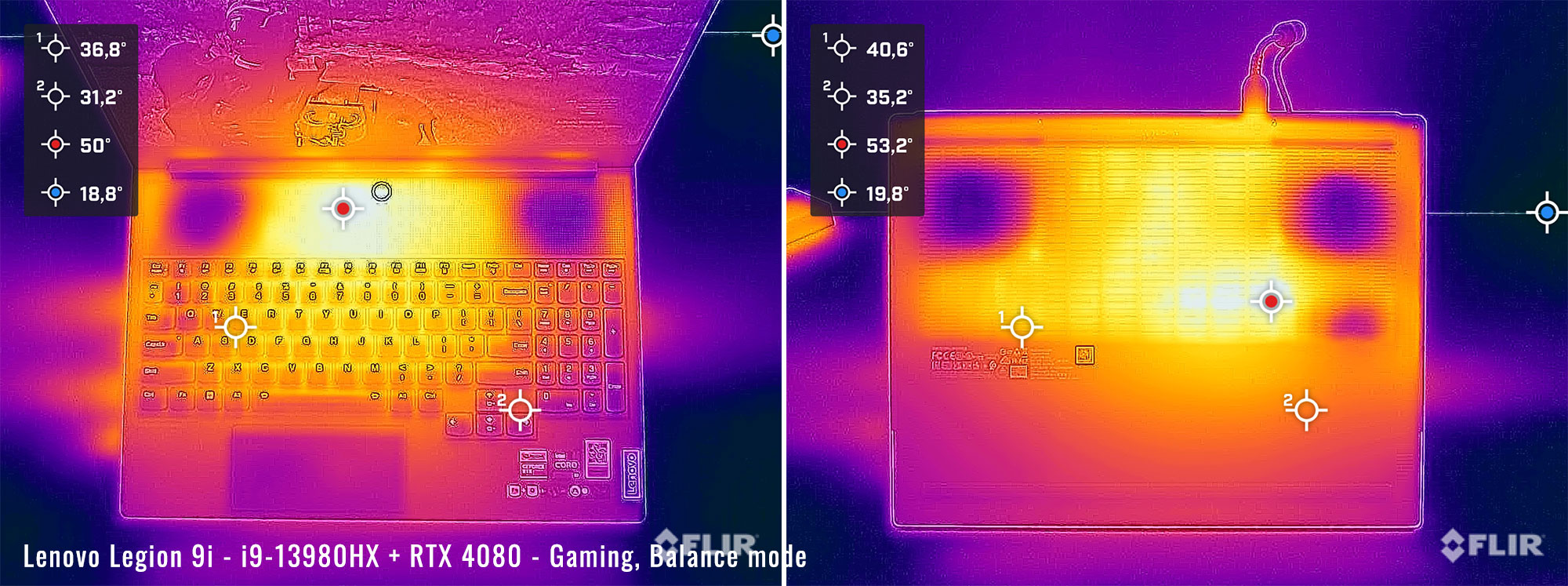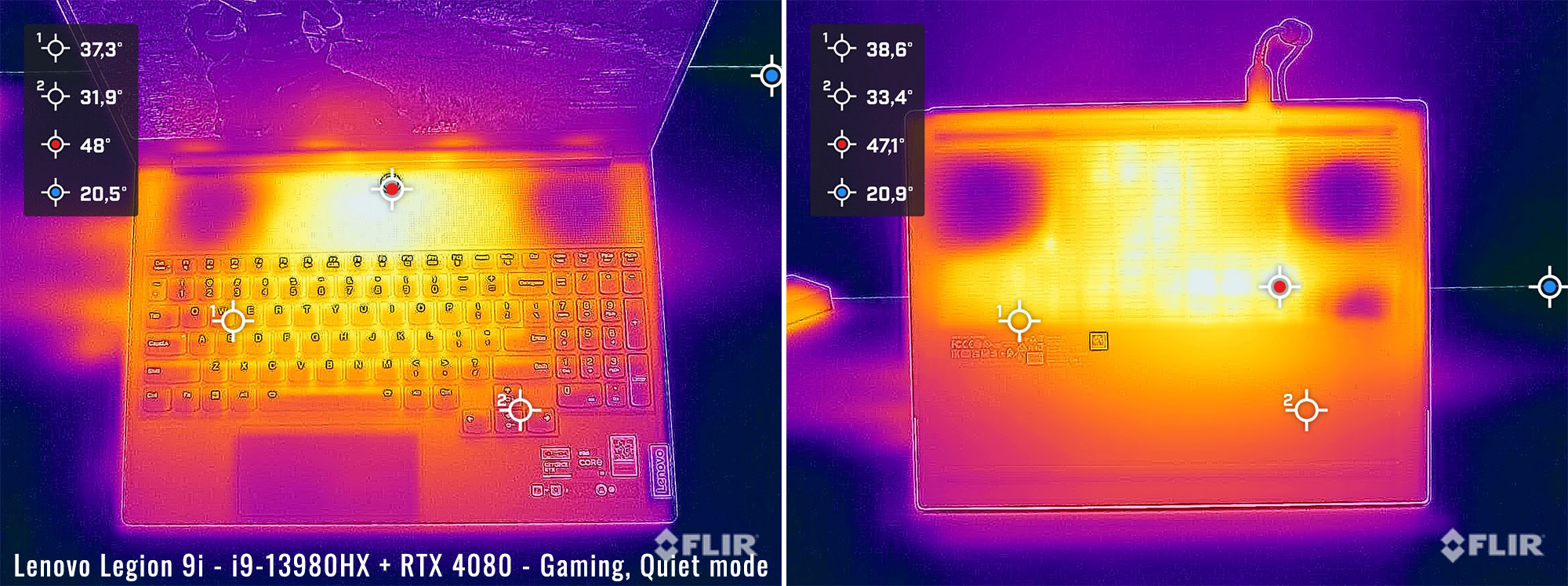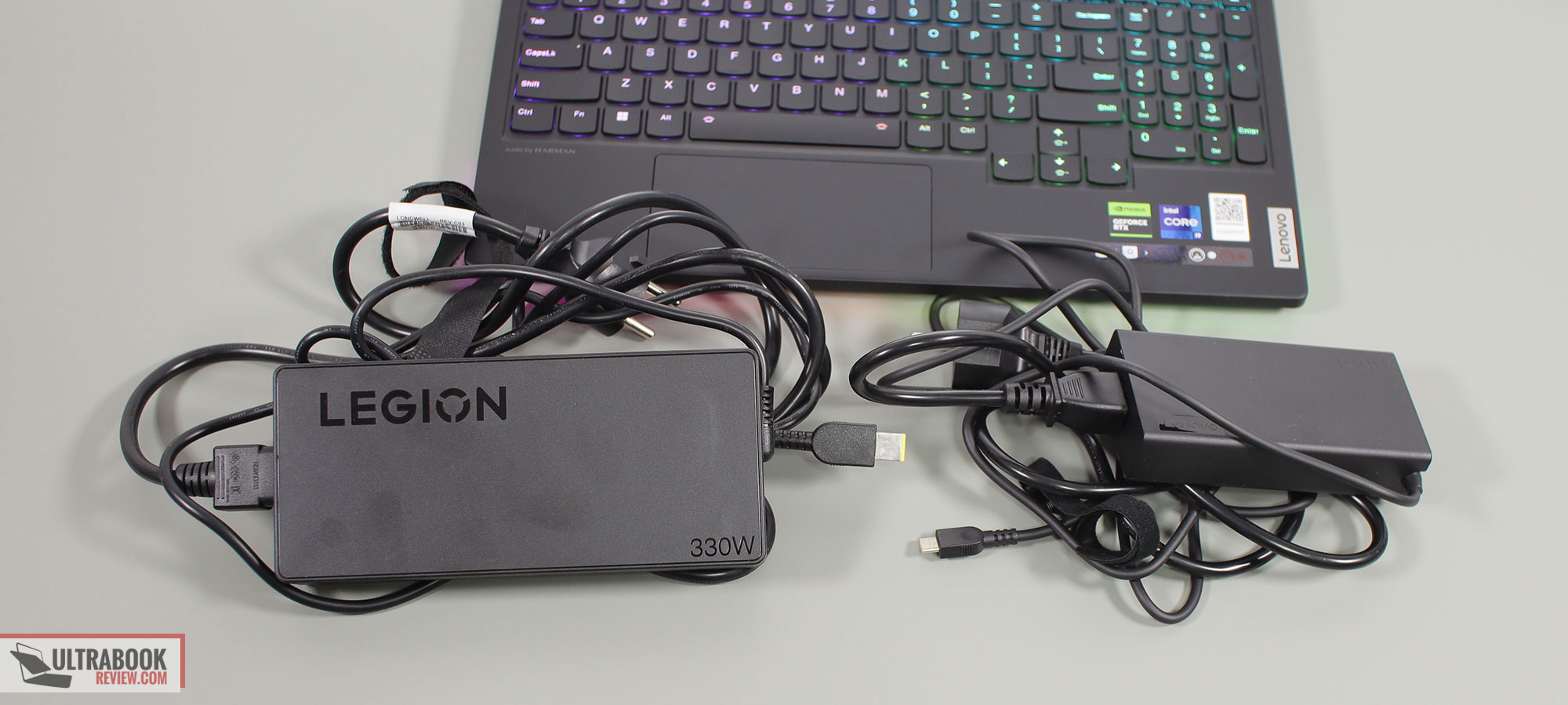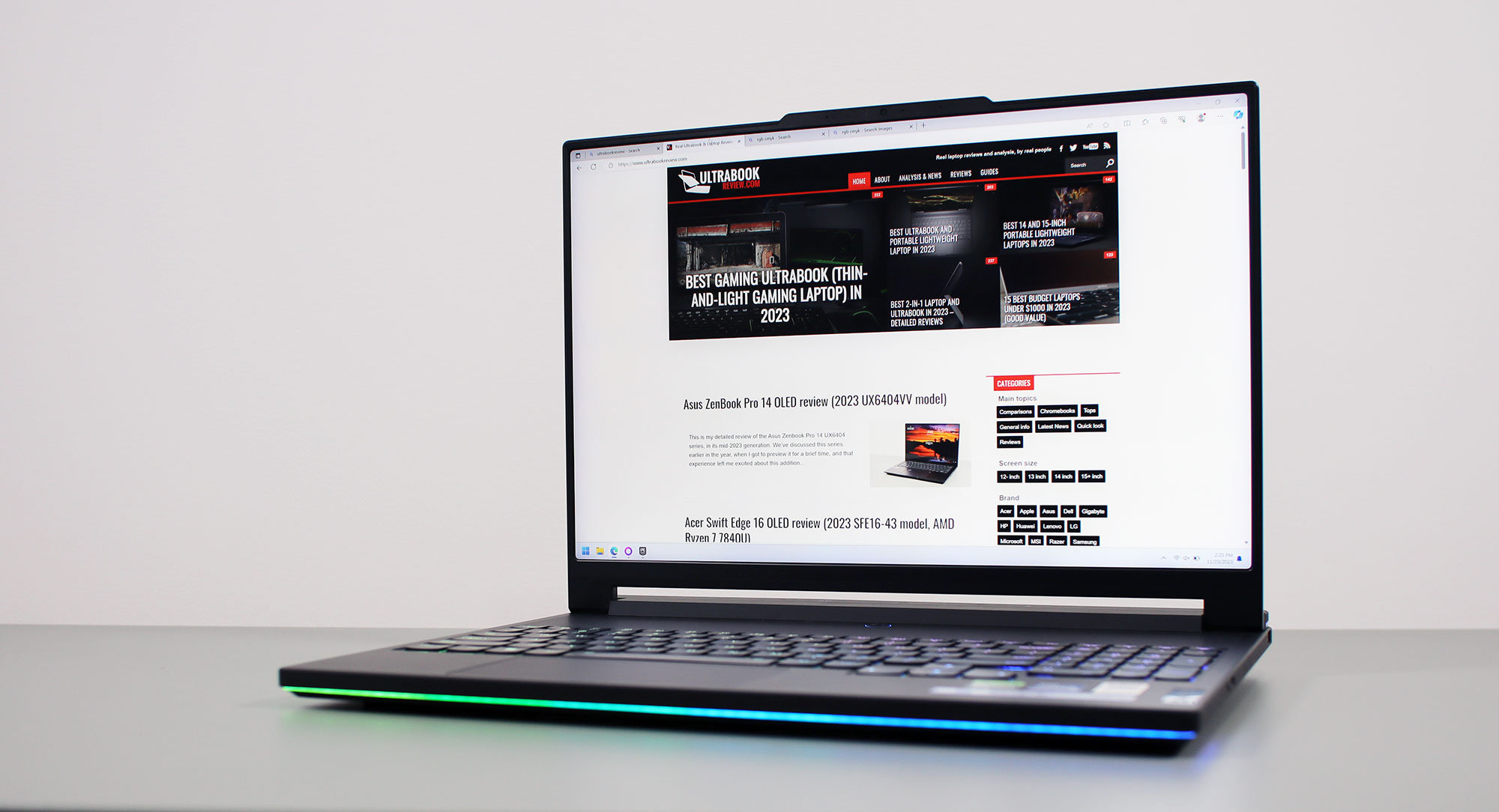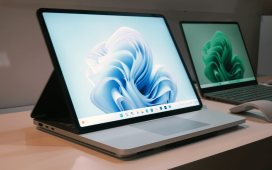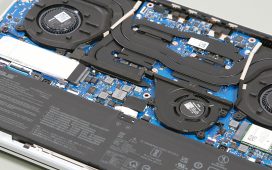This is my detailed review of the the Lenovo Legion 9i series, the highest-tier Legion laptop available as of the end of 2023.
You probably know what to expect from this series by now, which is Lenovo’s take on a somewhat portable high-performance laptop, and not an uncompromised full-size laptop as perhaps you might expect from a top-of-the-line Legion. Instead, Lenovo made this lineup thinner and lighter than their Pro 7 models, while bundling inside the fastest Intel and Nvidia hardware available at this point, and pretty much the best display money can buy today on a laptop.
The result is a beautiful premium chassis with some questionable ergonomics, and solid performance across the board, but not always on par with the fastest notebooks out there. All for a hefty price.
We’ll get in depth on all these aspects, as well as all the others that I would want to know when deciding on this Lenovo Legion 9i series, further down in this review.
Specs as reviewed- Lenovo Legion 9i
| Lenovo Legion 9i 16IRX8 (Gen 8, 2023 model year) | |
| Screen | 16 inch, 16:10 format, mini LED, matte, 3.2K 3200×2000 px, 165 Hz 3ms response, VRR support 800-nits SDR, 1200-nits peak HDR, 1536 dimming zones |
| Processor | Intel 13th-gen Raptor Lake HX, Core i9-13980HX, 8PC+16Ec/32T, up to 5.6 GHz Turbo |
| Video | Intel UHD + NVIDIA GeForce RTX 4080 with 12GB GDDR6 VRAM 150-175W, with MUX, Advanced Optimus, and GSync |
| Memory | 64 GB DDR5-5600 (2x DIMMs), up to 64 GB |
| Storage | 1 TB PCIe gen4 (Samsung PM9A1) – 2x M.2 2280 PCIe gen4 SSD slots |
| Connectivity | Wireless 7 (Killer 1675i) with Bluetooth 5.3, 2.5G LAN (Killer E3000) |
| Ports | Left: SD card reader 3.0, 1x audio jack Right: 1x USB-A 3.2 gen1, 1x USB-C 3.2 gen1 , 1x eShutter button Back: 1x USB-A gen1 (always on 5V2A), 2x Thunderbolt 4 (data, DP, 140W power), HDMI 2.1, LAN, DCI-In |
| Battery | 99.9 Whr, 330 W GaN power adapter and 140W USB-C charger |
| Size | 357.7 mm or 14.08” (w) x 277.7 mm or 10.93 (d) x 18.99 – 22.7 mm or .74″ – .89” (h) |
| Weight | 2.55 kg (5.62 lbs) + .95 kg (2.1 lbs) for the 330W charger+cables, EU version |
| Extras | per-key RGB backlit keyboard with NumPad, 1.5 mm travel, glass clickpad, finger-sensor in the power button, 2x 2W stereo speakers, FHD webcam with eShutter, tri-fan quad-radiator with self-contained liquid-cooling system, available in a Carbon Black |
There are a bunch of other configuration options for this series, the important one being an RTX 4090 16GB dGPU and various types and amounts of storage and RAM. The i9 CPU, the display and everything else are identical between units.
Design and construction
This 2023 Legion 9i is a premium-tier performance laptop that can easily rival any of the other competing products in terms of build quality and aesthetics, including devices like the Razer Blade 16, the Asus ROG Zephyrus M16 or the Alienware x16, which are more-or-less its main competitors.
Sure, this is still a gaming-themed laptop, with a black color and a handful of RGB elements all around. The lightbars on the front and back are subtle, though, some of the nicest I’ve seen on any product, and entirely controllable in the software, of course. The Legion logo on the lid is RGB as well, and controllable as well (although I couldn’t set the logo to light up in Spectrum on my unit, not sure why). That means all these can be switched off when looking for a more subdued appearance.
There’s nothing subtle about all the stickers plastered on the arm-rest, though, but at least they can be peeled off and I suggest to do it asap. Nothing subtle about the lid, either. which is this carbon-fiber alloy with an unique pattern of carbon flakes. I didn’t expect to like it, but it’s actually nicer in person than in the pictures. The looks, well, I’m fine with it, but I especially like the feel of this material, and how well it hides smudges and finger-prints. I never had to clean it during my time with the laptop.
The smooth black coating of the arm-rest and the black keycaps, on the other hand, those show smudges and will require a wipe every other day. I’ve included a picture of how my unit looks after a few days of heavy use.
Looks aside, this laptop has a big footprint, at 357 x 257 mm, larger than most other 16-inch laptops available today, including full-size options such as the Legion Pro 7 or the ROG Scar 16. It is slim, though, and that allows the chassis to feel comfortable with daily use. But impacts that way the internals and the cooling are designed, much like on the Alienware x16, which is another slim performance chassis. That means the top part of the chassis is reserved for cooling, which pushes the keyboard further down and minimizes the space left for the arm-rest.
Here’s a picture of the Legion 9i next to the more traditional Pro 7i. The keyboards are similar, but the arm-rest and touchpad are much smaller on the 9i, as the space above in reserved for cooling.
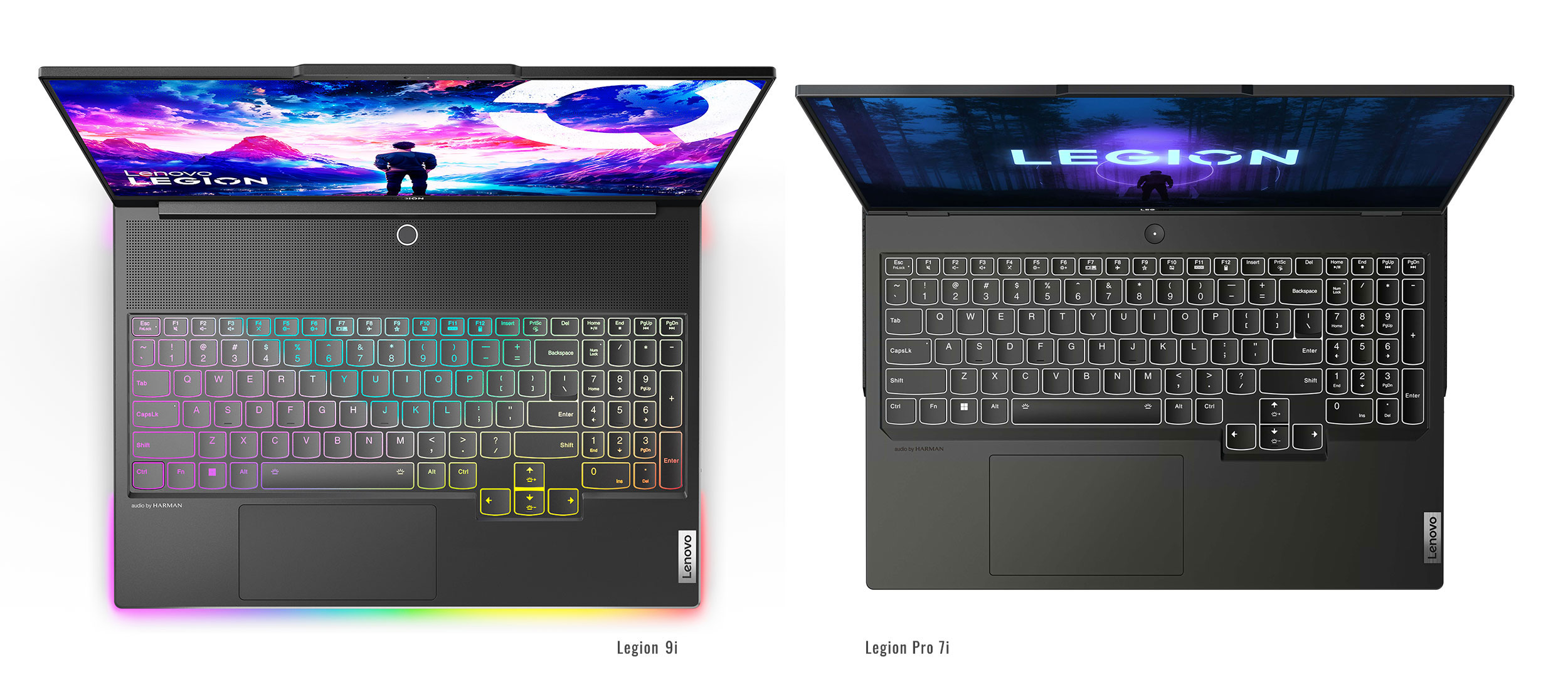
This design impacts the typing position and the ergonomics when not using the laptop on a spacious desk. Up to you if this aspect is important or not, especially when you’ll also factor in the fact that this Legion 9i is not really a portable model, because of its footprint and weight of 2.5+ kilos. Furthermore, having the keyboard lower on the chassis has a positive impact on the temperatures perceived at the keyboard level in demanding loads, which we’ll discuss further down.
This aspect aside, I will add two more nits that I have with this series: the display only leans back to about 140 degrees, and not all the way flat, and there’s an always-on light in the power button, somewhat annoying when using the laptop at night. At least it’s fairly dim and has some purpose, as it lights up in white/blue/red based on the active power profile, but I’d prefer to be able to switch this off entirely.
The power button also integrates a finger-sensor, like on the older Legion 7 Pro models, but a feature that was missing from the 2023 Legion Pro 7s.
On the other hand, I appreciate the sturdiness of this chassis and the way all the materials feels to the touch. I also appreciate that the lips and corners are blunted and friendly on the wrists, as well as the excellent grip of the rubber feet.
On the bottom of the laptop you’ll also notice the speakers, and that’s because there are still only two bottom-firring speakers on this Legion. I would have expected better, btu at least the quality is decent.
Finally, as far as the IO goes, there’s plenty here, with most ports on the back edge, behind the display. I like the variety and the positioning of the ports, and the only thing missing here is a Lock.
Initially, I thought the markup aren’t illuminated on my unit, but you can actually enable the lighting with Fn+U. The icon in the middle is for the water-loop, and only lights up when this becomes active. The power icon also only lights up when having the laptop plugged in (either via the main charger or via USB-C).
Keyboard and trackpad
The keyboard on this laptop is similar to the one implemented in the Legion Pro 7i 2023 models, with a main deck of full-sized and properly-spaced keys, plus a smaller NumPad section at the right. The directional keys are full-size and well-spaced out from everything around.
The keycaps are made from a soft-feeling plastic and have a small ditch in them. The stroke depth is 1.5 mm, shorter than on other gaming laptops, but the feedback is OK, but a little mushier than on past Legion laptops. Hence, I couldn’t quite reach my average typing speed and accuracy on this keyboard, but given enough time, I’d expect to get used to it after a while.
The typing position is also fine as long as you’re using the laptop on a spacious desk, but otherwise, on the lap or in cramped places, the narrow arm-rest will be an inconvenience that you will start noticing.
The lighting on this keyboard is RGB, and among the better in the laptop space, both in terms of hardware and software. Bright and uniform LEDs are placed under each keycap, and very little light shines out from underneath the keys. Per-key RGB control is possible in the Spectrum app, which is part of the Lenovo Vantage main control software.
Lenovo also implements here that neat functionality that only lights up the active keys when you’re pressing Fn. This way, it’s easier to find the required shortcut, and there are quite a few of them for different things.
Other details worth mentioning are the fact that you get useful physical indicators for CapsLock, FnLock, and NumLock on this layout. However, there’s still no way to set up a timeout period for the keyboard’s lighting, which means you’ll have to manually enable/disable the lights when needed. Not a deal-breaker, but an oddity for Lenovo laptops.
The clickpad on this laptop is a smooth glass surface that works well with swipes, taps, gestures, etc. It’s wide, but short at the same time, so you will struggle to performs certain gestures due to the lack of space.
Despite it’s small size, the surface still rattles with firmer taps, and the physical clicks in the corners are clunkier than I’d expect in this segment of premium devices.
So in conclusion, this trackpad is usable, but you’ll most likely want to connect a mouse for any serious activity on this laptop.
Finally, for biometrics, there’s a finger sensor in the power button here, but no IR capable camera.
Screen
There’s a 16-inch 16:10 display in the 2023 Legion 9i, like on many of the other modern Legion laptops.
However, the panel offered here is the star of this series and unlike on other Legions, a beautiful mini LED option.
This is 3200 x 2000 px 3.2K resolution, with 500+ nits of SDR brightness, 1000+ nits of peak HDR brightness, and 100% DCI-P3 color coverage. Plus, being a mini LED panel, this gets multiple dimming zones – I’ve yet to confirm this, but some sources mention 1536 dimming zones, which is denser than on other mini LED panels implemented on Windows laptops.
With real-use, I haven’t noticed any bad blooming and zone-lighting artefacts on this panel, although some spottiness is visible on gray and white backgrounds at lower brightness settings around 20-30%. That’s a quirk of the mini LED technology, as explained in this separate article on mini LED laptops.
So overall, this panel is an excellent option for daily use and media streaming, with punchy colors and excellent blacks and contrast. It’s a matte finish, so perhaps not as vivid as some of the OLEDs available today, but still excellent across the board. And better for HDR content, due to the much higher peak brightness than what OLED panels offer on laptops today.
This is also a fine option for gaming, albeit the resolution is non-standard at 3.2K, which will matter for modern titles in case you’re not going to game at the max resolution, bur rather choose 1600p for better framerates. That will result in some image fuzziness due to the scaling from 3.2K to 2.5K. Furthermore, this panel only supports up to 165 Hz refresh-rates, while the QHD+ mini LED options available today go up to 240Hz. The response times are also a little slower on this panel than on those aforementioned QHD+ mini LEDs offered by competing products. These are perhaps small details, but worth considering in your decision.
Here’s what we got in our tests, with an X-Rite i1 Display Pro sensor:
- Panel HardwareID: CSOT T3 MGN0007DA2-3;
- Coverage: 100.0% sRGB, 87.7% DCI-P3, 97.5% AdobeRGB;
- Measured gamma: 2.16;
- Max brightness in the middle of the screen: 670.1 cd/m2 on power;
- Min brightness in the middle of the screen: 8.52 cd/m2 on power;
- Contrast at max brightness: 1:1;
- White point: 6600 K;
- Black on max brightness: 0.0 cd/m2;
- PWM: Yes.
This panel is well calibrated out of the box, and uniform in luminosity. However, we measured some weird color imbalances between quadrants, due to the always active dimming zones, and that might impact the accuracy of this panel for color-precise work. Not sure if these readings are quite right, though, as the software that we’re using isn’t designed for mini LED panels with zone dimming.
Nonetheless, I would appreciate if Lenovo would offer here the option that Asus have on their mini LED laptops, where you can manually switch between single-zone and multi-zone lighting, based on your need. Disabling the dimming-zones would allow for better uniformity and precision for color-work, while activating the dimming-zones leads to the amazing daily-use and media experience offered by this technology. As it is, with the zones always active, I don’t think this implementation is ideal for Photoshop/Premiere, but perhaps there’s something I’m missing about how the zones work here. Let me know in the comments section.
Hardware and performance
Our test model is the mid-specced configuration of the 2023 Lenovo Legion 9i, built on an Intel Core i9-13980HX processor, 64 GB of DDR5-5600 memory, 1 TB of fast SSD storage, and dual graphics: the Nvidia RTX 4080 12GB dGPU and the Intel iGPU integrated within the Intel processor.
Disclaimer: This is a retail unit provided for this review by Lenovo, and it runs on the software available as of late-November 2023 (BIOS –KWCN37W, Vantage 3.13.72.0, GeForce 546.17 drivers). By this point, this is a mature software package, and very little might still change with later updates.
Spec-wise, the 2023 Legion 9i is built on the latest and most powerful Intel and Nvidia hardware available to date.
The Core i9-13980HX is the top Intel Raptor Lake 13th-gen high-performance mobile processor, with 24 Cores and 32 Threads. This clocks a little higher than the i9-13900HX available in the Legion Pro 7i lineups, at 5.6 GHz max Turbo vs 5.4 GHz, but otherwise the two processors are identical.
This i9 is a hybrid design with 8 Performance cores, 16 Efficiency cores, and a total of 32 Threads, which work together in the various loads. The design and thermal module of this Legion 9i allow the processor to run at ~120W of sustained power in demanding CPU loads, a bit lower than the 130-140W possible in the Legion Pro 7i models we’ve tested.
For the GPU, the 2023 Legion 9i series is available with full-power RTX 4000 graphics chips. This unit is the Nvidia GeForce RTX 4080 12GB running at up to 175W with Dynamic Boost. And RTX 4090 16GB 175Wconfiguration is available as well.
A MUX is offered here, with Advanced Optimus. The Vantage control app also allows for a couple of working modes such as Hybrid and dGPU-0nly.
For the RAM, the series offers two DDR5 DIMMs. Our unit is a 64 GB of DDR5-5600 RAM (2x 16 GB) configuration.
For storage, there are two M.2 2280 PCIe gen4 slots on this series, and our sample comes preconfigured with a fast gen4 1 TB Samsung PM9A1 drive.
Getting to the components requires you to remove a few Philips screws, all visible around the back panel, and then pull up this D-panel. You might need a plastic pin and some sort of suction cup to pull it out, as it is snugly attached to the main chassis.
Inside, the motherboard is an inverted design, so the cooling module and the RAM slots are not easily accessible. But the SSD slots, at least, are, once you take out the protective metal shields.
For the software, this unit came with Windows 11 preinstalled and the standard set of Lenovo apps – you might want to uninstall some of them.
The power profiles are Quiet, Balance, Balance with Legion Ai, and Performance, and you can select them from Vantage or switch between them with Fn+Q. There’s also an advanced Custom mode that allows granular tweaking of various settings and power limits. It’s a welcomed addition for the 2023 Legion generations.
These profiles apply different power settings to the CPU/GPU and different fan profiles, as well as switch the color of the LED in the power button. Here’s a table that shows what each mode does, with the tested BIOS and software package:
| Quiet (blue) | Balance (white) | Balance+ Ai (white) | Performance (red) | Custom (red) | |
| CPU only, PL1/PL2 TDP | 60/125W | 75/125W | 75/125W | 125/175W | 130/175W |
| GPU only, max TGP | 55W | 100W | 175W | 175W | 175W |
| Crossload Max GPU TDP + GPU TGP |
~100W, 45 + 55W | ~135W, 35W + 100W | ~205W, 35W + 170W | ~210W, 35 + 175W | ~230W, 55 + 175W |
| Noise at head-level, tested | ~35 dBA | ~42 dBA | ~50 dBA | ~50 dBA | ~56 dBA |
This series also offers a quick dGPU Overclocking toggle, which applies +100 MHz Core, +200 MHz Memory settings. We’ve used this setting for all our tests, but further tweaking is also possible if you want to.
Before we jump to the performance section, here’s how this laptop handles everyday use and multitasking on the Quiet/Balance profiles, unplugged from the wall.
Performance and benchmarks
On to more demanding loads, we start by testing the CPU’s performance by running the Cinebench R15 test for 15+ times in a loop, with a 1-2 seconds delay between each run.
With the laptop sitting on the desk and on Performance mode, the Core i9-13980HX processor kicks in at ~175 W of peak power, and then stabilizes at ~120W of sustained power. The CPU is power-limited and the cores’ temperatures stabilize at around 90 degrees Celsius. In comparison, the i9-13900HX stabilizes at around 130W in the Legion Pro 7i, with temperatures around 82-84 C. That’s a notable difference.
Maxing out the settings in the Custom mode and raising the laptop on a stand in order to favor airflow into the fans doesn’t impact the performance in any notable way, despite the fact that the CPU power seems to stabilize a little higher, at around 125W. The fans run much louder in this mode, at 56 dBA vs 50 dBA on Performance.
Switching over to the Balance profile (without Legion Ai) translates into the CPU being power capped at ~75W sustained. The fans run significantly quieter, initially at 45 dBA, and then settling at around 38 dBA once the power cap kicks in, after a few loops. The CPU temperatures stabilize at mid-70s C. The performance takes a 30% dip with this sort of power limit.
On Balance with Legion Ai enabled, the CPU still stabilizes at 70W after a few runs, but the fans don’t drop under 42 dBA. Hence, the CPU temperatures are lower, around 65 C, but the performance is the same.
On Balance without Legion Ai and USB-C power (with the 140W included charger), the CPU runs at around 50W sustained, with 38 dBA fan-noise and temperatures in the 60s. The performance is about 60% of what the laptop scores on Performance, and lower than on Balance with the main charger connected.
The Quiet profile keeps the fans at sub 35 dBA, with a power limit of around 65W sustained and temperatures in the low-60s. All these translate in ~65% of the performance of the top profile. That’s not bad.
Finally, the CPU runs at ~50W of sustained power on battery, on the Balance profile. Details below.
Overall, these profiles are well polished, and quite conservative on the Balance and Quiet modes, I might add. The power limits ensure that the laptop is never thermally limited in any sustained CPU load, and there’s a good variation of noise/power between the available settings. However, all these power limits are lower than on the Legion Pro 7i chassis, while the CPU runs at higher temperatures.
To put these findings in perspective, here’s how this Core i9-13980HX implementation fares against the i9-13900HX in the Legion Pro 7i laptops. The i9 in the Pro 7i scores a little bit higher, because it runs at higher sustained power. However, the i9-13980HX scores higher on the Balance and especially the Quiet profiles.
And here’s how it fares against other high-performance laptops tested so far, either Intel or AMD.
The Legion 9i scores towards the bottom of this chart, only beating the Razer Blade 16, which is an even lower-powered i9 implementation. Devices such as the Scar 16 or the Alienware m16 outscore the Legion 9i by 15%, while the Ryzen 9 HX processor is 30% faster in this sort of multithreaded load. On top of that, the AMD laptop is the quietest of the bunch, but it is a slightly larger 17-inch chassis.
With these out of the way, we went ahead and further verified our findings with the more taxing Cinebench R23 loop test and Blender – Classroom, which resulted in similar findings to those explained above.
We also ran the 3DMark CPU test on the Performance profile.
Finally, we ran our combined CPU+GPU stress tests on this notebook. 3DMark stress runs the same test for 20 times in a loop and looks for performance variation and degradation over time, and this unit passed it just fine when kept flat on the desk, which means there’s no performance throttling with longer-duration sustained loads.
Next, we ran the entire suite of tests and benchmarks, on the Performance profile with the GPU set on the Hybrid mode (MUX on Advanced Optimus), and with the screen set at the native QHD+ resolution.
Here’s what we got:
- 3DMark 13 – CPU profile: max – 12360, 16 – 9426, 8 – 7886, 4 – 4360, 2 – 2274, 1 – 1170;
- 3DMark 13 – Fire Strike (DX11): 32881 (Graphics – 40573, Physics – 39206, Combined – 12344);
- 3DMark 13 – Port Royal (RTX): 12129;
- 3DMark 13 – Time Spy (DX12): 18831 (Graphics – 19008, CPU – 17893);
- 3DMark 13 – Speed Way (DX12 Ultimate): 4863;
- Uniengine Superposition – 1080p Extreme: -13700;
- Uniengine Superposition – 1080p Medium: 29312;
- Handbrake 1.3.3 (4K to 1080p encode): 79.09 average fps;
- Handbrake 1.6.1 (4K to 1080p encode): 117.84 average fps;
- Handbrake 1.7.0 (4K to 1080p encode): 122.15 average fps;
- PCMark 10: 7905 (Essentials – 11656, Productivity – 10949, Digital Content Creation – 10505);
- GeekBench 5.5.1 64-bit: Multi-core: 20440, Single-Core: 1983;
- GeekBench 6.0.2: Multi-core: 16876, Single-Core: 2675;
- CineBench R15 (best run): CPU 4583 cb, CPU Single Core 296 cb;
- CineBench R20 (best run): CPU 10884 cb, CPU Single Core 789 cb;
- CineBench R23: CPU 28476 cb (best single run), CPU 27352 cb (10 min run), CPU Single Core 2105 cb;
- x265 HD Benchmark 64-bit: 20.31 s.
And here are some workstation benchmarks, on the same Performance profile:
- Blender 3.01 – BMW scene – CPU Compute: 1m 22s ;
- Blender 3.01 – BMW scene – GPU Compute: 10.23s (CUDA), 5.93s (Optix);
- Blender 3.01 – Classroom scene – CPU Compute: 3m 21s;
- Blender 3.01 – Classroom scene – GPU Compute: 19.43s (CUDA), 12.97s (Optix);
- Blender 3.41 – BMW scene – CPU Compute: 1m 20s;
- Blender 3.41 – BMW scene – GPU Compute: 9.91s (CUDA), 5.19 (Optix);
- Blender 3.41 – Classroom scene – CPU Compute: 3m 24s;
- Blender 3.41 – Classroom scene – GPU Compute: 17.33s (CUDA), 9.84s (Optix);
- PugetBench – DaVinci Resolve: 1790 points;
- PugetBench – Adobe After Effects: 1192;
- PugetBench – Adobe Photoshop: 1275;
- PugetBench – Adobe Premiere: 809;
- SPECviewperf 2020 – 3DSMax: 177.54;
- SPECviewperf 2020 – Catia: 97.26;
- SPECviewperf 2020 – Creo: 130.53;
- SPECviewperf 2020 – Energy: 64.19;
- SPECviewperf 2020 – Maya: 530.84;
- SPECviewperf 2020 – Medical: 50.91;
- SPECviewperf 2020 – SNX: 33.41;
- SPECviewperf 2020 – SW: 394.10.
- V-Ray Benchmark: — 20174 – CPU, 2673 – CUDA, 3558 – RTX.
The CPU scores are higher in single-core and short duration multicore tests than on the i9-13900HX configuration of the Legion Pro 7i models we’ve tested. But the sustained CPU multithreaded performance is a little lower, due to the CPU running at lower power in the 9i.
The GPU performance is on par with other full-power RTX 4080 laptops we’ve tested.
The RTX 4090 configuration will score up to 20% higher in regular benchmarks, and up to 25% higher in RT tests. The 4090 also comes with extra vRAM, which will make an impact in certain loads.
Legion 9i vs. Legion Pro 7i (RTX 4080, RTX 4090)
Here’s how this Legion 9i configuration (i9 + RTX 4080) fairs in benchmarks against the Legion Pro 7i units (i9 with RTX 4080 or 4090) tested earlier in the year.
| i9-13980HX + 4080 175W 2023 Legion 9i |
i9-13900HX + 4090 175W 2023 Legion Pro 7i |
i9-13900HX + 4080 175W 2023 Legion Pro 7i |
|
| 3DMark – Fire Strike | 32881 (G – 40573, P – 392063, C – 12344) | 35744 (G – 47175, P – 38696, C – 11193) | 31551 (G – 40636, P – 37173, C – 10867) |
| 3DMark – Port Royal | 12129 | 14063 | 12211 |
| 3DMark – Time Spy | 18831 (Graphics – 19008, CPU – 17893) | 20953 (Graphics – 21882, CPU – 16890) | 18781 (Graphics – 19578, CPU – 15262) |
| Uniengine Superposition – 1080p Extreme | -7187 | 13700 | 10718 |
| CineBench R23 (best run) | 28476 cb – multi core, 2105 cb – single core |
29549 cb – multi core, 1988 cb – single core |
30747 cb – multi core, 2045 cb – single core |
| Blender 3.01 – Classroom scene – CPU Compute | -3m 21s | 3m 21s | 3m 31s |
| Blender 3.01 – Classroom scene – GPU Compute | -19.43s (CUDA), 12.97s (Optix) | 19.43s (CUDA), 12.97s (Optix) | 24.06s (CUDA), 15.32s (Optix) |
| PugetBench – Adobe Photoshop | 1275 | 1213 | 1172 |
| PugetBench – DaVinci After Effects | 1990 | 1990 | 1850 |
| SPECviewperf 2020 – 3DSMax: | 177.54 | 199.64 | 180.38 |
| SPECviewperf 2020 – Catia: | 97.26 | 111.44 | 104.06 |
| SPECviewperf 2020 – Maya: | 530.84 | 542.53 | 563.95 |
The Legion 9i bundles the i9-13980HX processor, and scores a little better in the brief CPU tests. But then, the sustained CPU power is a little lower on the Legion 9i, that’s why the i9-13900HX in the Legion Pro 7i units scores better in sustained CPU tests such as Blender and Cinebench R23.
On the GPU side, the RTX 4080 in the Legion 9i and Legion Pro 7i units score similarly, within the margin of error of a few percentages of each other.
The RTX 4090 is a faster chip, 10-20% faster than the 4080 in the synthetic tests, and up to 25% faster in RT tests. However, the performance gap shrinks in the real-life workloads. Blender is an exception, where the 4090 keeps a notable advantage over the 4080.
The RTX 4090 in the Legion 9i will perform similarly to the one tested in the Legion Pro 7i unit.
Custom, Balance, Quiet modes
Let’s also touch on the Custom, Balance and Quiet profiles offered in Vantage.
Here’s how this 2023 Legion 9i performs on the Custom profile, with the highest possible power settings and fans set to 100% rpms (which translates in 56+ dBA at head level).
–updating
- 3DMark 13 – Fire Strike: -35309 (Graphics – 46436, Physics – 38438, Combined – 12096);
- 3DMark 13 – Time Spy: -21580 (Graphics – 22500, CPU – 17521);
- Uniengine Superposition – 1080p Extreme: –13905;
- CineBench R20 (best run): -CPU 10884 cb, CPU Single Core 759 CB;
- Blender 3.41 – Classroom scene – CPU Compute: –3m 23s.
—
Next, if you’re willing to sacrifice the performance to some extent to keep the fans quieter than on Performance (~50 dBA), the Balance and Quiet profiles should be of interest.
Here’s how this 2023 Legion 9i performs on the Balance profile, with Ai disabled, which limits the fans to around 42 dB at head level.
–updating
- 3DMark 13 – Fire Strike: –31818 (Graphics – 40344, Physics – 36439, Combined – 11466);
- 3DMark 13 – Time Spy: –15861 (Graphics – 15718, CPU – 16728);
- Uniengine Superposition – 1080p Extreme: —10367;
- CineBench R20 (best run): –CPU 9924 cb, CPU Single Core 764 CB;
- Blender 3.41 – Classroom scene – CPU Compute: —4m 24s.
—
You can also opt for the Quiet profile, in which case the fans won’t go over 35 dB. Here’s what we got in this case:
–updating
- 3DMark 13 – Fire Strike: –17994 (Graphics – 26558, Physics – 19059, Combined – 5138);
- 3DMark 13 – Time Spy: –11543 (Graphics – 11814, CPU – 10217);
- Uniengine Superposition – 1080p Extreme: –6401;
- CineBench R20 (best run): –CPU 5674 cb, CPU Single Core 701 CB;
- Blender 3.41 – Classroom scene – CPU Compute: –6m 24s.
—
USB-C power
Lenovo bundles a 140W USB-C power with the laptop, a more portable alternative to the 330W main charger. However, only a limited Balance mode is available on USB-C power, with less performance than when using the main charger. We’ll discuss how this Legion 9i works on USB-C power in a separate article.
Gaming performance
Let’s see how this RTX 4080 configuration of the Lenovo Legion 9i handles modern games.
We tested a couple of different types of games on the various available profiles at 3.2K, QHD+ and FHD+ resolution, all with the MUX manually set on the dGPU mode and the GPU on the Overclocked mode.
Here are the results:
| Lenovo Legion 9i, Core i9-13980HX + RTX 4080 Laptop 150-175W |
3.2K Performance, dGPU, on desk |
3.2K Custom max, dGPU, on desk |
QHD+ Performance, dGPU, on desk |
QHD+ Balance, Ai, dGPU, on desk |
QHD+ Balance, no Ai, dGPU, on desk |
FHD+ Performance, dGPU, on desk |
FHD+ Quiet, dGPU, on desk |
| Cyberpunk 2077 (DX 12, Ultra Preset, RTX OFF) |
60 fps (38 fps – 1% low) | 61 fps (41 fps – 1% low) | 85 fps (57 fps – 1% low) | 85 fps (58 fps – 1% low) | 72 fps (50 fps – 1% low) | 125 fps (93 fps – 1% low) | 80 fps (54 fps – 1% low) |
| Doom Eternal (Vulkan, Ultra Preset) |
236 fps (198 fps – 1% low) | – | 338 fps (262 fps – 1% low) | – | 268 fps (168 fps – 1% low) | 444 fps (322 fps – 1% low) | 252 fps (196 fps – 1% low) |
| Far Cry 6 (DX 12, Ultra Preset, TAA) |
99 fps (78 fps – 1% low) | 102 fps (82 fps – 1% low) | 123 fps (88 fps – 1% low) | 123 fps (92 fps – 1% low) | 101 fps (78 fps – 1% low) | 135 fps (92 fps – 1% low) | 90 fps (62 fps – 1% low) |
| Far Cry 5 (DX 11, Ultra Preset, SMAA) |
118 fps (94 fps – 1% low) | – | 148 fps (109 fps – 1% low) | – | 123 fps (95 fps – 1% low) | 166 fps (106 fps – 1% low) | 123 fps (88 fps – 1% low) |
| Metro Exodus (DX 12, Ultra Preset, RTX OFF) |
82 fps (62 fps – 1% low) | – | 103 fps (68 fps – 1% low) | – | – | 136 fps (76 fps – 1% low) | – |
| Red Dead Redemption 2 (DX 12, Ultra Optimized, TAA) |
82 fps (40 fps – 1% low) | – | 128 fps (42 fps – 1% low) | – | 82 fps (36 fps – 1% low) | 136 fps (44 fps – 1% low) | 84 fps (32 fps – 1% low) |
| Resident Evil 4 (DX 12, Prioritize Graphics, TAA) |
102 fps (56 fps – 1% low) | – | 138 fps (60 fps – 1% low) | – | 110 fps (52 fps – 1% low) | 190 fps (88 fps – 1% low) | 114 fps (72 fps – 1% low) |
| Shadow of Tomb Raider (DX 12, Highest Preset, TAA) |
110 fps (88 fps – 1% low) | 112 fps (92 fps – 1% low) | 148 fps (102 fps – 1% low) | 147 fps (104 fps – 1% low) | 122 fps (89 fps – 1% low) | 165 fps (114 fps – 1% low) | 118 fps (78 fps – 1% low) |
| The Witcher 3: Wild Hunt (v4.04) (DX 12, Ultra Preset, TAAU) |
122 fps (57 fps – 1% low) | 125 fps (55 fps – 1% low) | 136 fps (60 fps – 1% low) | 136 fps (62 fps – 1% low) | 127 fps (56 fps – 1% low) | 138 fps (65 fps – 1% low) | 122 fps (70 fps – 1% low) |
- Battlefield V, Cyberpunk, Doom, Witcher 3 – recorded with Fraps/in-game FPS counter in campaign mode;
- Far Cry 5, 6, Metro, Red Dead Redemption 2, Tomb Raider – recorded with the included Benchmark utilities;
- Red Dead Redemption 2 Optimized profile based on these settings.
Those above are rasterization tests, and here are some results for RTX – Ray Tracing performance, with and without DLSS.
| Lenovo Legion 9i, Core i9-13980HX + RTX 4080 Laptop 150-175W |
3.2K Performance, dGPU | QHD+ Performance, dGPU | FHD+ Performance, dGPU |
| Cyberpunk 2077 (DX 12, Ultra Preset + RTX, DLSS3 Off) |
25 fps (16 fps – 1% low) | 38 fps (26 fps – 1% low) | 63 fps (40 fps – 1% low) |
| Cyberpunk 2077 (DX 12, Ultra Preset + RTX, DLSS3 Balanced) |
84 fps (56 fps – 1% low) | 114 fps (70 fps – 1% low) | 162 fps (123 fps – 1% low) |
| Doom Eternal (DX 12, Ultra Preset, RTX On, DLSS2 Off) |
162 fps (138 fps – 1% low) | 226 fps (182 fps – 1% low) | 322 fps (254 fps – 1% low) |
| Doom Eternal (DX 12, Ultra Preset, RTX On, DLSS2 Quality) |
202 fps (162 fps – 1% low) | 272 fps (220 fps – 1% low) | 366 fps (260 fps – 1% low) |
| Far Cry 6 (DX 12, Ultra Preset + DXR reflections / shadows) |
88 fps (66 fps – 1% low) | 106 fps (81 fps – 1% low) | 114 fps (86 fps – 1% low) |
| Shadow of Tomb Raider (DX 12, Highest Preset, TAA, RTX Ultra, DLSS2 Off) |
70 fps (52 fps – 1% low) | 97 fps (68 fps – 1% low) | 128 fps (81 fps – 1% low) |
| Shadow of Tomb Raider (DX 12, Highest Preset, TAA, RTX Ultra, DLSS2 On) |
78 fps (54 fps – 1% low) | 112 fps (69 fps – 1% low) | 129 fps (74 fps – 1% low) |
| The Witcher 3: Wild Hunt (v4.04 update) (DX 12, RT Ultra Preset, TAAU, DLSS3 Off) |
64 fps (44 fps – 1% low) | 80 fps (48 fps – 1% low) | 92 fps (61 fps – 1% low) |
| The Witcher 3: Wild Hunt (v4.04 update) (DX 12, RT Ultra Preset, DLSS3 On) |
68 fps (40 fps – 1% low) | 94 fps (52 fps – 1% low) | 132 fps (66 fps – 1% low) |
This configuration runs smoothly in all these modern games at QHD+ resolution and Ultra settings. RT performance is also impressive for this 4090 variant, especially with DLLS3 in supported titles.
RTX 4090 vs. RTX 4080 gaming performance
Here’s how this RTX 4080 Legion 9i configuration fares in a few games against the RTX 4090 and RTX 4080 configurations in the Legion Pro 7i, all the QHD+ resolution with Ultra settings.
| Legion 9i 2023, Core i9-13980HX + RTX 4080 175W, QHD+ Performance, dGPU, on desk |
Legion Pro 7i 2023, Core i9-13900HX + RTX 4090 175W, QHD+ Performance, dGPU, on desk |
Legion Pro 7i 2023, Core i9-13900HX + RTX 4080 175W, QHD+ Performance, dGPU, on desk |
|
| Cyberpunk 2077 (DX 12, Ultra Preset, RTX OFF) |
85 fps (57 fps – 1% low) | 98 fps (68 fps – 1% low) | 75 fps (45 fps – 1% low) |
| Cyberpunk 2077 (DX 12, Ultra Preset + RTX, DLSS3 Off) |
38 fps (26 fps – 1% low) | 43 fps (68 fps – 1% low) | 35 fps (68 fps – 1% low) |
| Cyberpunk 2077 (DX 12, Ultra Preset + RTX, DLSS3 Balanced) |
114 fps (70 fps – 1% low) | 128 fps (68 fps – 1% low) | 110 fps (68 fps – 1% low) |
| Far Cry 6 (DX 12, Ultra Preset, TAA) |
123 fps (88 fps – 1% low) | 125 fps (88 fps – 1% low) | 120 fps (82 fps – 1% low) |
| Red Dead Redemption 2 (DX 12, Ultra Optimized, TAA) |
128 fps (42 fps – 1% low) | 134 fps (47 fps – 1% low) | 121 fps (38 fps – 1% low) |
| Shadow of Tomb Raider (DX 12, Highest Preset, TAA) |
148 fps (102 fps – 1% low) | 162 fps (92 fps – 1% low) | 147 fps (59 fps – 1% low) |
I haven’t included Witcher 3 results in here, because we tested these configurations with different versions of the game available at the time. But you’ll find the results, as long as other gaming tests, in the reviews.
Overall, this is a solid implementation of the RTX 4080 Laptop chip, and handles gaming at 3.2K and QHD+ resolution fine even with Ultra settings. However, with RT, 3.2K becomes tough without DLSS, so you might have to go to QHD. But in that case, the image isn’t going to be as sharp as on the native resolution, due to the scaling from 3.2K to 2.5K. Hence, I mostly agree that a 2.5K mini LED panel would have made more sense on this laptop as far as the gaming experience goes.
With that out of the way, let’s go through some logs.
On this unit, the Performance mode ramps up the fans to levels of ~50 dB with the laptop sitting on the desk. That’s loud, and you’ll most likely need headphones to cover it up.
These settings keep hardware at solid temperatures, though, with both the CPU and the GPU averaging around 76-80 degrees Celsius.
Raising the back of the laptop from the desk doesn’t change anything here, because the cooling system is designed to primarily draw in fresh air from the top of the laptop, and thus the fans are not chocked up with the laptop flat on the desk, as on the other Legions designs. Hence, this is a laptop that can game on the desk just fine.
Opting for the Custom mode and ramping up the fans to 100% translates into noise levels of 56 dBA at head level. This mode pushes more power into the CPU, but overall the components still run at excellent temperatures in the mid to high 70s.
This mode seems to be the only one that actually activates the water-cooled extra loop that Lenovo make a big fuss about on this laptop, and we’ll discuss in the next section.
For the most part, this Custom profile is rather superfluous here, but it does help lower the external chassis temperatures. That 56 dBA fan noise, though, pretty much means you won’t be able to use the laptop in this mode in any place where there are other people around.
Then there’s the Balance mode. With the AI Engine disabled, the fans stabilize at around 42 dBA.
The hardware is power-limited as well, with around 100W allocated to the GPU and 35W to the CPU. That means the framerates take a dip, of around 20% more or less.
The CPU/GPU temperatures are still excellent, though. Here’s what we got with the laptop flat on the desk.
And here’s how temperatures are impacted when raising up the back for better airflow. In this case, with the slower spinning fans, bumping the laptop on a stand actually makes a notable difference.
Balance mode with Legion Ai enabled is a weird mode, as it causes the laptop to pretty much perform just like in Performance mode. Same framerates, same temperatures, same fan noise of 50 dBA.
As for the Quiet mode, it keeps the fans at sub 35 dB levels and limits the power on the CPU and GPU to ~90W crossload and 55W GPU. Thus, this mode is slower than the others, significantly slower, but I still found it adequate for gaming at FHD+ and even QHD+ resolution with High/Ultra settings. And the experience is so much more enjoyable without the fan noise.
Noise, Heat, Connectivity, speakers, and others
This Legion 9i gets an advanced thermal module design, with three-fans, five radiators, a multitude of heatpipes, and an extra self-contained water loop.
You’ll have to take out the motherboard to get to the cooling module, which I haven’t done here.
But, Dave2D’s video below does an excellent job discussing the cooling module on this laptop, as he got access to a preview mockup of the thermal module. This is discussed from around 2:39.
I’ll summarize a few points on this cooling design:
- This laptop is not primarily water cooled, as some article might suggest. The heatpipes and radiators are in charge of the cooling.
- There is indeed a small water-loop implements, with a tiny pump and one heatpipe connected into the pump. This heatpipe goes over the GPU’s VRMs, and the water loop only activates when the internal temperatures go over 84 degrees Celsius (I’d reckon that’s when the GPU or the VRMs reach 84 C – this is not clear to me, and I don’t have insiders with Lenovo to ask for clarification). From my tests, this never happens when running games on either the Balance or Performance modes. In fact, the only mode where the pump is active is Custom, with everything maxed out and the fans set on Full Speed mode. Even on Custom, with the fans on a Custom curve, that pump doesn’t seem to activate, simply because the GPU never reaches that 84C limit.
- And even when/if the water-loop becomes active, I fail to understand what it does exactly, because the water-loop heatpipe is not connected to any radiator that would be used to dissipate the heat. So the heat just builds into the liquid and I don’t see how it is cooled, other than just passively trough the pump’s metal casing.
So long story short, the purpose of this whole water-loop in a Legion 9i is mystery to me, other than perhaps a marketing gimmick meant to impress naive members of press, and eventually potential buyers.
What’s funny is that this laptop doesn’t even need the loop. The cooling module on this Legion 9i does an excellent job at keeping the CPU/GPU at bay, pretty much at sub 80 degrees Celsius on all profiles and in all the games I’ve tested. The CPU/GPU temperatures on this laptop are overall lower than on all the other performance laptops we’ve tested with similar specs, perhaps with the exception of the Alienware m16 (haven’t tested the Alienware x16, but that runs cool as well, from what I’ve seen in other reviews).
Furthermore, with most of the air coming inside through the top of the chassis, through the intakes above the keyboard, placing the laptop on a stand doesn’t impact thermals as much as on other Legions and other laptops with traditional bottom-first intakes.
As far as the fan noise goes, we’re looking at ~50 dB at head-level on the Performance mode, 42 dB on Balance mode (without Legion Ai Engine), and sub 35 dB on Quiet mode, all with demanding activities. And 56 dBA on Custom with max fans.
With light daily use, the fans rarely idle even on Quiet mode, and you’ll heat their humming in a quiet environment when they’re active, especially since all three of them activate at the same time when they do. I’d hope for a way to force these idle with light use, like other brands do, as the internal temperatures would allow it (the CPU stays at ~50 dBA with light use). Eventually, the fans would idle when using the laptop on battery power and for very basic activities, but then will come active when you open a browser or other apps.
At least I haven’t noticed any coil winning or electronic noises on this unit.
As far as the chassis temperatures go, no complaints with daily use. The chassis runs in the 30s, and the hottest spot is at the bottom of the display.
*Daily Use – streaming Netflix in EDGE for 30 minutes, Quiet profile, fans sub 30 dBA
Things change somehow with long gaming and work sessions.
On Performance mode and with the laptop on a flat surface, a hotspots develops in the top-middle part of the chassis, around the power button and where the CPU/GPU are placed inside. These spots hits 55+ on the interior, while the hottest part on the bottom gets closer to 60 C.
The areas around WASD and arrow keys keep only warmer, in the low 30s for the arrows and mid 40s for the WASD keys. With longer sessions, the metal case around the WASD keys starts to feel a little uncomfortable to the touch.
*Gaming – Performance, laptop on desk – playing Witcher 3 for 30 minutes, fans at ~50 dBA
I also tested the Custom mode with 100% rpm fans, which increases the noise to ~56 dBA, with the laptop on a raiser stand. There’s still that hot-spot around the power button, but the rest of the laptop keeps much cooler.
*Gaming – Custom with max fans – playing Witcher 3 for 30 minutes, fans at ~56 dBA
This Legion 9i also feels cooler to the touch in Balance mode, which also tames down the fans and the temperatures. But be aware that this also takes a ~20% toll on the framerates and overall performance.
Down below is what we got on Balance mode with the laptop on a flat surface, and placing this on a stand will lead to a slight further decrease in surface temperatures. It’s still hot around the power button, but merely warm everywhere else.
*Gaming – Balance– playing Witcher 3 for 30 minutes, fans at ~42 dBA
Finally, this is what to expect when playing games in Quiet mode. More or less similar reading to Balance mode, and lower than the Performance. This mode only provides about half the performance of the top profiles, but with barely audible fans at sub 35 dBA.
*Gaming – Quiet– playing Cyberpunk for 30 minutes, fans at ~35 dBA
In conclusion, the Legion 9i never overheats with demanding loads and gaming sessions, and overall is more comfortable to use than the toastier Legions Pro 7is of this generation.
For connectivity, there’s Wireless 6E and Bluetooth 5.3 through an Intel-based Killer 1675i chip on this laptop, as well as 2.5G LAN. The wireless proved fast and reliable during my time with the laptop. The wired connection should be fast, but I haven’t tested it.
Audio is handled by two bottom-firing speakers, which seem similar to the ones in the Legion Pro 7s. They can get loud, at 80 dBA at head-level, but the quality is about average, with fairly little in bass. These are not quite on par with the 4/6 speakers systems offered by the competition, and I was hoping for better in this new top-tier Legion.
Finally, I’ll mention the camera placed at the top of the screen and flanked by microphones. Both are fine for calls. What I do appreciate is the physical camera switch on the right edge of the laptop, which easily enables/kills both the camera and the mics when you want to. The camera on this unit lacks IR and support for the Tobii Horizon software.
Battery life
There’s a 99.9Wh battery inside the Legion 9i, which is the largest possible in a notebook.
The system automatically switches the screen’s refresh to 60 Hz when you unplug the laptop, which I think is a first for Lenovo laptops. This causes the screen to become black for a split second when plugging/unplugging. You can also cycle between the refresh modes by hitting Fn+R.
So here’s what we got on our unit, with the screen’s brightness set at around 120 nits (~60 brightness) and 60Hz refresh.
- 25 W (~4 h of use) – idle, Quiet Mode, screen at 60%, Wi-Fi ON;
- 20 W (~5-6 h of use) – text editing in Google Drive, Quiet Mode, screen at 60%, Wi-Fi ON;
- 20 W (~5 h of use) – 1080p fullscreen video on Youtube in Edge, Quiet Mode, screen at 60%, Wi-Fi ON;
- 23 W (~4 h of use) – 4K HDR fullscreen video on Youtube in Edge, Quiet Mode, screen at 60%, Wi-Fi ON;
- 18 W (~4-5 h of use) – 4K Netflix with Dolby Vision, fullscreen in Edge, Quiet Mode, screen at 60%, Wi-Fi ON;
- 33 W (~3 h of use) – browsing in Edge, Balance Mode, screen at 60%, Wi-Fi ON;
The runtimes on battery power aren’t amazing on this Intel HX platform, and the mini LED panel takes its toll as well. They’re not utterly bad, either, in comparison to other HX performance laptops.
I’ll also add that Lenovo pairs this configuration with an updated 330W power brick, a dual-piece design with long cables and a more compact GaN power brick. In total, they weigh .95 of a kilo.
They also include a 140W USB-C charger, another dual-piece design with a smaller brick and lighter weight at around .5 kilos. This is a more portable option for traveling for your laptop, just keep in mind that you’re only given access to a limited Balance mode on USB-C power, with less performance than when using the main charger. We’ll discuss how this works on USB-C power in a separate article.
Price and availability
The Legion 9i is available in stores in most regions at the time of this article.
The Intel i9 + RTX 4080 configuration reviewed here is listed at Lenovo’s US store at $3799, but currently sells for around $3199 with 32 GB RAM/ 1 TB of storage. Over here in Europe you can get it for around 4000 EUR.
The Intel i9 + RTX 4090 model is a roughly 500 USD/EUR extra.
Follow this link for updated configurations and prices in your region at the time you’re reading this article.
Final thoughts- 2023 Lenovo Legion 9i review
The Legion 9i is rather controversial, but overall a surprisingly good performance laptop.
I’d reckon many expected this 9i to be a full-performance uncompromised model, but Lenovo decided otherwise. In fact, this would have probably made more sense as a Legion Slim 9i, and would have set more correct expectations this way, as it is a powerful laptop in a thin chassis, which leads to some compromises.
Surprisingly, thermals are not a concern here, unlike on other slim notebooks, even if the water-loop part is rather non-sense, as the water loop is only in charge of VRMs and doesn’t connect on a radiator, and in fact never seems to activate anyway during gameplay and demanding loads, at least on my unit. But even so, this 9i runs cooler than all the other thicker Legion laptops of this generation.
It’s also a good performer, especially on the GPU side, as on the CPU side the power is somewhat limited in comparison to other Core i9 HX platforms, including the Legion Pro 7i. But for mixed-use in work applications and games, this is as fat as it gets.
However, the display that Lenovo chose for this series, while stunningly beautiful, is arguably not quite the right choice for gaming. That’s because the 3.2K resolution is a little high even for the 4080 in the most recent titles, and if you’ll decide to lower the resolution to 1600p, the image isn’t going to look as sharp as on the native resolution, due to how Windows handles scaling from 3.2K to 2.5K. Furthermore, the 3.2K mini LED panel takes isn’t quite as fast as the QHD+ mini LEDs offered by the competition, which again might matter for certain games. So perhaps Lenovo tried a little too hard with this panel.
Where they didn’t try is audio quality, which could be better. The experience with the inputs isn’t ideal either, with the keyboard being shifted further down onto the chassis in order to leave space for cooling on this slim chassis, which results in a small touchpad.
But despite all these, I quite enjoyed my time with this laptop. The design and attention to detail in second to none within the Legion lineup, and that display is so beautiful for everyday use. Now, I’m not sure when you draw the line the 9i is worth the significant premium asked by Lenovo, and I guess they’re aware of it as well, since they already offer hefty discounts for both the 4080 and the 4090 configurations. In the US, that is, as over here in Europe the prices are still absurd, alongside those of Razer and Alienware laptops.
But I am sure that this Lenovo Legion 9i is quite a good laptop overall, despite its compromises and quirks and high price.

